Sociology 2270: Analysis of 'Muslim Grooming Gangs' Research Article
VerifiedAdded on 2022/08/20
|30
|18312
|227
Report
AI Summary
This report analyzes the research article by Cockbain and Tufail, which examines the 'Muslim grooming gangs' narrative in the UK, a discourse that has become prominent in media and political debates surrounding child sexual exploitation. The authors argue that this narrative is misleading, sensationalist, and promotes various harms, including racist framings of Muslim men. The article explores how this narrative exists in both extremist and mainstream discourses, often legitimized by supposedly liberal and feminist actors and pseudoscientific research. The authors trace the architects of this narrative, including the media, politicians, and special interest groups, and discuss its impact. They propose alternative, anti-racist feminist approaches to address child sexual exploitation, focusing on the needs of victims and tackling sexual violence without demonizing entire communities. The report also addresses the research issue, concerns about previous research, and the authors' objectives in conducting this study, which is to challenge the dominant narrative and offer alternative perspectives to understand and respond to child sexual exploitation effectively.
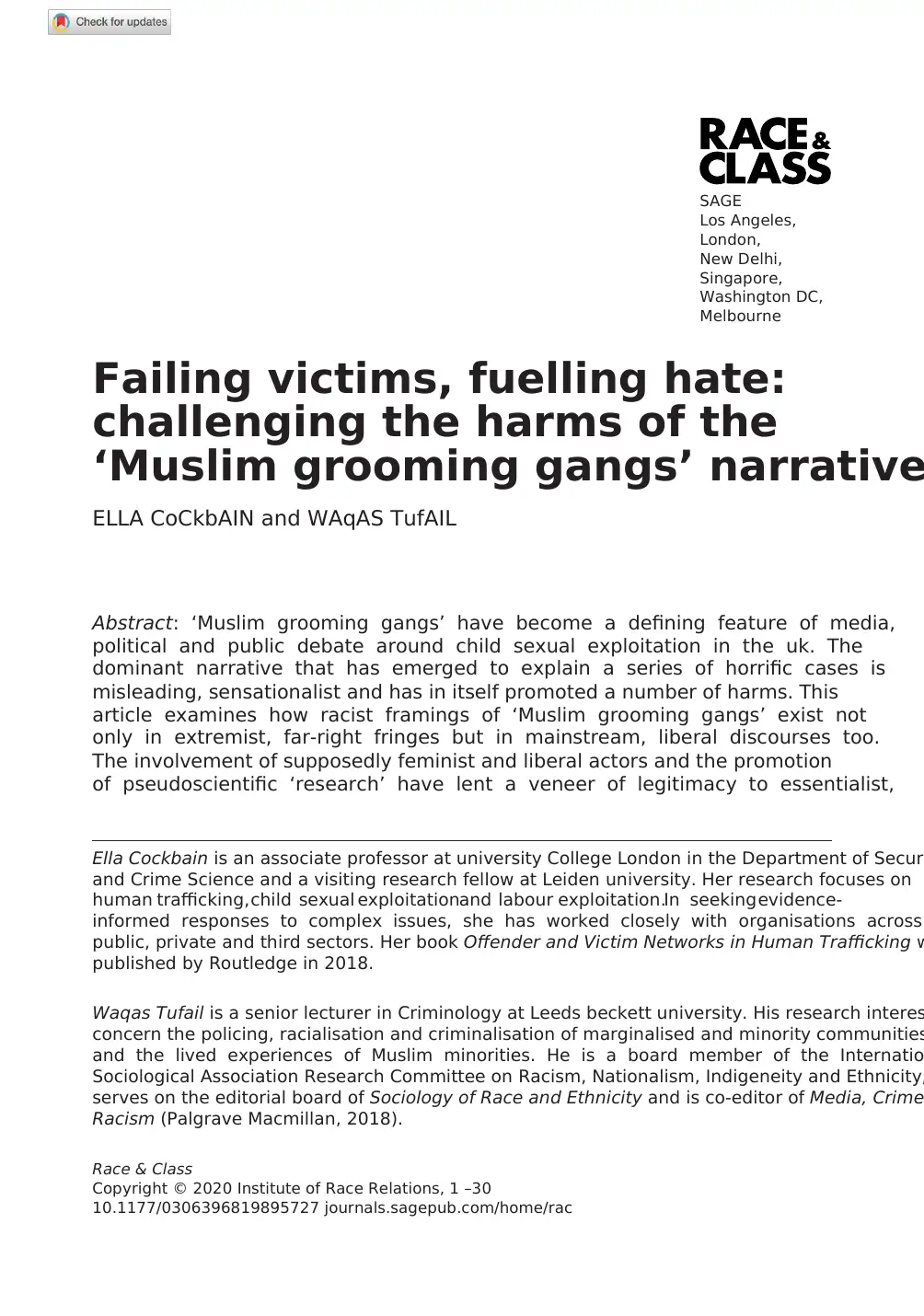
Race & Class
Copyright © 2020 Institute of Race Relations, 1 –30
10.1177/0306396819895727 journals.sagepub.com/home/rac
SAGE
Los Angeles,
London,
New Delhi,
Singapore,
Washington DC,
Melbourne
Failing victims, fuelling hate:
challenging the harms of the
‘Muslim grooming gangs’ narrative
ELLA CoCkbAIN and WAqAS TufAIL
Abstract: ‘Muslim grooming gangs’ have become a defining feature of media,
political and public debate around child sexual exploitation in the uk. The
dominant narrative that has emerged to explain a series of horrific cases is
misleading, sensationalist and has in itself promoted a number of harms. This
article examines how racist framings of ‘Muslim grooming gangs’ exist not
only in extremist, far-right fringes but in mainstream, liberal discourses too.
The involvement of supposedly feminist and liberal actors and the promotion
of pseudoscientific ‘research’ have lent a veneer of legitimacy to essentialist,
Ella Cockbain is an associate professor at university College London in the Department of Securi
and Crime Science and a visiting research fellow at Leiden university. Her research focuses on
human trafficking, child sexual exploitationand labour exploitation.In seeking evidence-
informed responses to complex issues, she has worked closely with organisations across
public, private and third sectors. Her book Offender and Victim Networks in Human Trafficking w
published by Routledge in 2018.
Waqas Tufail is a senior lecturer in Criminology at Leeds beckett university. His research interes
concern the policing, racialisation and criminalisation of marginalised and minority communities
and the lived experiences of Muslim minorities. He is a board member of the Internatio
Sociological Association Research Committee on Racism, Nationalism, Indigeneity and Ethnicity,
serves on the editorial board of Sociology of Race and Ethnicity and is co-editor of Media, Crime
Racism (Palgrave Macmillan, 2018).
895727RAC0010.1177/0306396819895727Race & ClassCockbain and Tufail
research-article2020
Copyright © 2020 Institute of Race Relations, 1 –30
10.1177/0306396819895727 journals.sagepub.com/home/rac
SAGE
Los Angeles,
London,
New Delhi,
Singapore,
Washington DC,
Melbourne
Failing victims, fuelling hate:
challenging the harms of the
‘Muslim grooming gangs’ narrative
ELLA CoCkbAIN and WAqAS TufAIL
Abstract: ‘Muslim grooming gangs’ have become a defining feature of media,
political and public debate around child sexual exploitation in the uk. The
dominant narrative that has emerged to explain a series of horrific cases is
misleading, sensationalist and has in itself promoted a number of harms. This
article examines how racist framings of ‘Muslim grooming gangs’ exist not
only in extremist, far-right fringes but in mainstream, liberal discourses too.
The involvement of supposedly feminist and liberal actors and the promotion
of pseudoscientific ‘research’ have lent a veneer of legitimacy to essentialist,
Ella Cockbain is an associate professor at university College London in the Department of Securi
and Crime Science and a visiting research fellow at Leiden university. Her research focuses on
human trafficking, child sexual exploitationand labour exploitation.In seeking evidence-
informed responses to complex issues, she has worked closely with organisations across
public, private and third sectors. Her book Offender and Victim Networks in Human Trafficking w
published by Routledge in 2018.
Waqas Tufail is a senior lecturer in Criminology at Leeds beckett university. His research interes
concern the policing, racialisation and criminalisation of marginalised and minority communities
and the lived experiences of Muslim minorities. He is a board member of the Internatio
Sociological Association Research Committee on Racism, Nationalism, Indigeneity and Ethnicity,
serves on the editorial board of Sociology of Race and Ethnicity and is co-editor of Media, Crime
Racism (Palgrave Macmillan, 2018).
895727RAC0010.1177/0306396819895727Race & ClassCockbain and Tufail
research-article2020
Paraphrase This Document
Need a fresh take? Get an instant paraphrase of this document with our AI Paraphraser
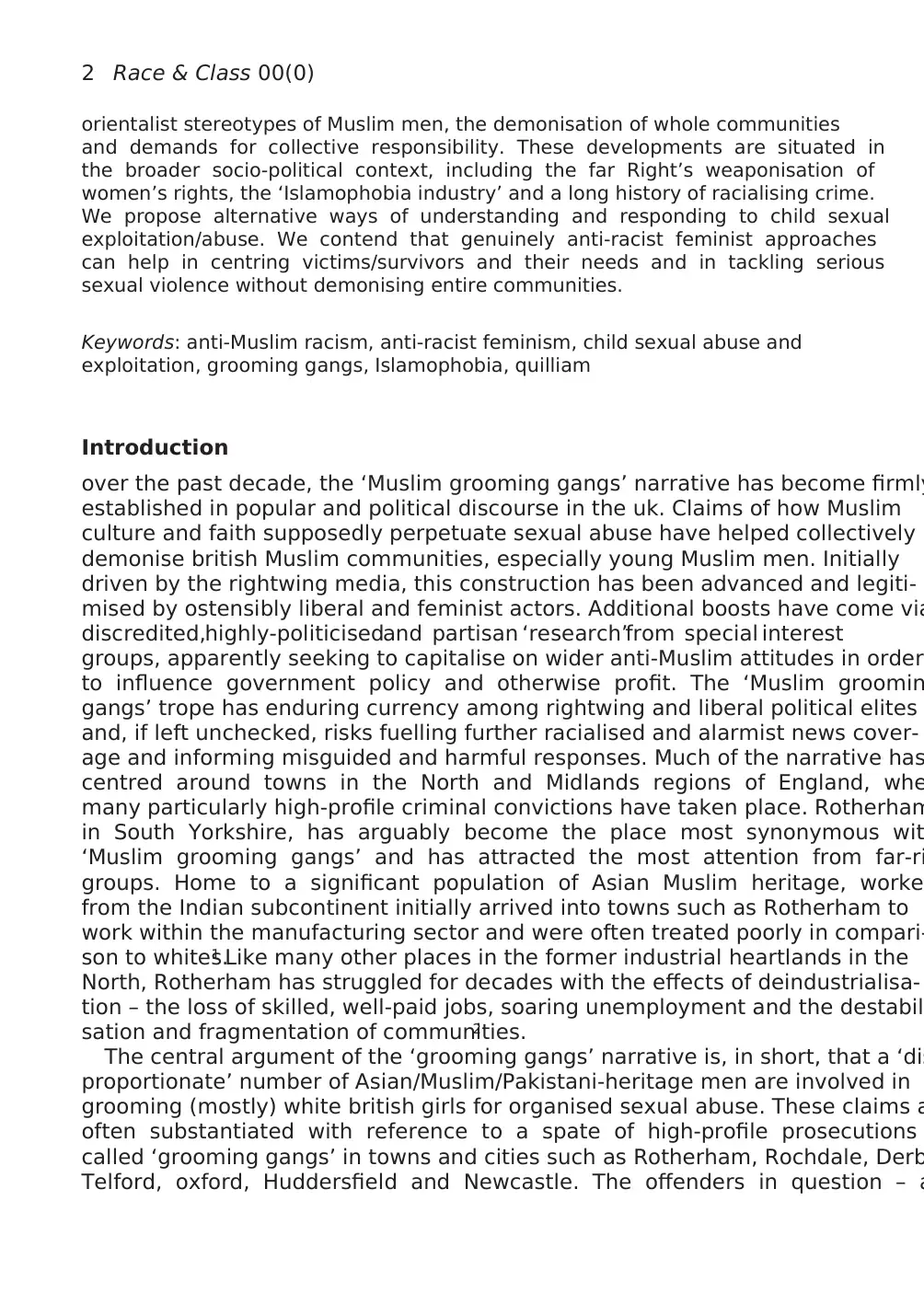
2 Race & Class 00(0)
orientalist stereotypes of Muslim men, the demonisation of whole communities
and demands for collective responsibility. These developments are situated in
the broader socio-political context, including the far Right’s weaponisation of
women’s rights, the ‘Islamophobia industry’ and a long history of racialising crime.
We propose alternative ways of understanding and responding to child sexual
exploitation/abuse. We contend that genuinely anti-racist feminist approaches
can help in centring victims/survivors and their needs and in tackling serious
sexual violence without demonising entire communities.
Keywords: anti-Muslim racism, anti-racist feminism, child sexual abuse and
exploitation, grooming gangs, Islamophobia, quilliam
Introduction
over the past decade, the ‘Muslim grooming gangs’ narrative has become firmly
established in popular and political discourse in the uk. Claims of how Muslim
culture and faith supposedly perpetuate sexual abuse have helped collectively
demonise british Muslim communities, especially young Muslim men. Initially
driven by the rightwing media, this construction has been advanced and legiti-
mised by ostensibly liberal and feminist actors. Additional boosts have come via
discredited,highly-politicisedand partisan ‘research’from special interest
groups, apparently seeking to capitalise on wider anti-Muslim attitudes in order
to influence government policy and otherwise profit. The ‘Muslim groomin
gangs’ trope has enduring currency among rightwing and liberal political elites
and, if left unchecked, risks fuelling further racialised and alarmist news cover-
age and informing misguided and harmful responses. Much of the narrative has
centred around towns in the North and Midlands regions of England, whe
many particularly high-profile criminal convictions have taken place. Rotherham
in South Yorkshire, has arguably become the place most synonymous wit
‘Muslim grooming gangs’ and has attracted the most attention from far-ri
groups. Home to a significant population of Asian Muslim heritage, worke
from the Indian subcontinent initially arrived into towns such as Rotherham to
work within the manufacturing sector and were often treated poorly in compari-
son to whites.1 Like many other places in the former industrial heartlands in the
North, Rotherham has struggled for decades with the effects of deindustrialisa-
tion – the loss of skilled, well-paid jobs, soaring unemployment and the destabil
sation and fragmentation of communities.2
The central argument of the ‘grooming gangs’ narrative is, in short, that a ‘dis
proportionate’ number of Asian/Muslim/Pakistani-heritage men are involved in
grooming (mostly) white british girls for organised sexual abuse. These claims a
often substantiated with reference to a spate of high-profile prosecutions
called ‘grooming gangs’ in towns and cities such as Rotherham, Rochdale, Derb
Telford, oxford, Huddersfield and Newcastle. The offenders in question – a
orientalist stereotypes of Muslim men, the demonisation of whole communities
and demands for collective responsibility. These developments are situated in
the broader socio-political context, including the far Right’s weaponisation of
women’s rights, the ‘Islamophobia industry’ and a long history of racialising crime.
We propose alternative ways of understanding and responding to child sexual
exploitation/abuse. We contend that genuinely anti-racist feminist approaches
can help in centring victims/survivors and their needs and in tackling serious
sexual violence without demonising entire communities.
Keywords: anti-Muslim racism, anti-racist feminism, child sexual abuse and
exploitation, grooming gangs, Islamophobia, quilliam
Introduction
over the past decade, the ‘Muslim grooming gangs’ narrative has become firmly
established in popular and political discourse in the uk. Claims of how Muslim
culture and faith supposedly perpetuate sexual abuse have helped collectively
demonise british Muslim communities, especially young Muslim men. Initially
driven by the rightwing media, this construction has been advanced and legiti-
mised by ostensibly liberal and feminist actors. Additional boosts have come via
discredited,highly-politicisedand partisan ‘research’from special interest
groups, apparently seeking to capitalise on wider anti-Muslim attitudes in order
to influence government policy and otherwise profit. The ‘Muslim groomin
gangs’ trope has enduring currency among rightwing and liberal political elites
and, if left unchecked, risks fuelling further racialised and alarmist news cover-
age and informing misguided and harmful responses. Much of the narrative has
centred around towns in the North and Midlands regions of England, whe
many particularly high-profile criminal convictions have taken place. Rotherham
in South Yorkshire, has arguably become the place most synonymous wit
‘Muslim grooming gangs’ and has attracted the most attention from far-ri
groups. Home to a significant population of Asian Muslim heritage, worke
from the Indian subcontinent initially arrived into towns such as Rotherham to
work within the manufacturing sector and were often treated poorly in compari-
son to whites.1 Like many other places in the former industrial heartlands in the
North, Rotherham has struggled for decades with the effects of deindustrialisa-
tion – the loss of skilled, well-paid jobs, soaring unemployment and the destabil
sation and fragmentation of communities.2
The central argument of the ‘grooming gangs’ narrative is, in short, that a ‘dis
proportionate’ number of Asian/Muslim/Pakistani-heritage men are involved in
grooming (mostly) white british girls for organised sexual abuse. These claims a
often substantiated with reference to a spate of high-profile prosecutions
called ‘grooming gangs’ in towns and cities such as Rotherham, Rochdale, Derb
Telford, oxford, Huddersfield and Newcastle. The offenders in question – a
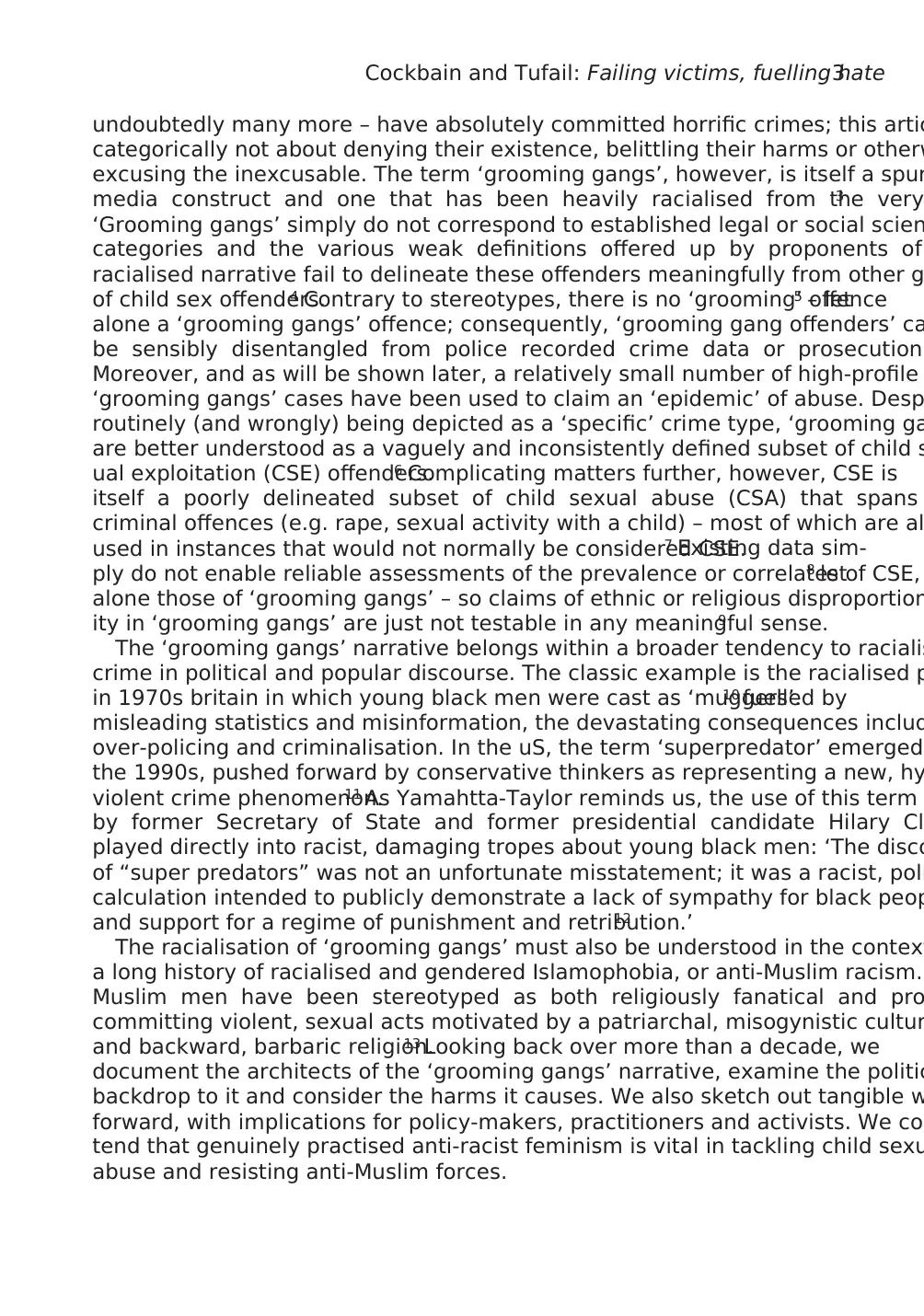
Cockbain and Tufail: Failing victims, fuelling hate3
undoubtedly many more – have absolutely committed horrific crimes; this artic
categorically not about denying their existence, belittling their harms or otherw
excusing the inexcusable. The term ‘grooming gangs’, however, is itself a spur
media construct and one that has been heavily racialised from the very3
‘Grooming gangs’ simply do not correspond to established legal or social scien
categories and the various weak definitions offered up by proponents of
racialised narrative fail to delineate these offenders meaningfully from other g
of child sex offenders.4 Contrary to stereotypes, there is no ‘grooming’ offence5 – let
alone a ‘grooming gangs’ offence; consequently, ‘grooming gang offenders’ ca
be sensibly disentangled from police recorded crime data or prosecution
Moreover, and as will be shown later, a relatively small number of high-profile
‘grooming gangs’ cases have been used to claim an ‘epidemic’ of abuse. Desp
routinely (and wrongly) being depicted as a ‘specific’ crime type, ‘grooming ga
are better understood as a vaguely and inconsistently defined subset of child s
ual exploitation (CSE) offenders.6 Complicating matters further, however, CSE is
itself a poorly delineated subset of child sexual abuse (CSA) that spans
criminal offences (e.g. rape, sexual activity with a child) – most of which are al
used in instances that would not normally be considered CSE.7 Existing data sim-
ply do not enable reliable assessments of the prevalence or correlates of CSE,8 let
alone those of ‘grooming gangs’ – so claims of ethnic or religious disproportion
ity in ‘grooming gangs’ are just not testable in any meaningful sense.9
The ‘grooming gangs’ narrative belongs within a broader tendency to racialis
crime in political and popular discourse. The classic example is the racialised p
in 1970s britain in which young black men were cast as ‘muggers’.10 fuelled by
misleading statistics and misinformation, the devastating consequences includ
over-policing and criminalisation. In the uS, the term ‘superpredator’ emerged
the 1990s, pushed forward by conservative thinkers as representing a new, hy
violent crime phenomenon.11 As Yamahtta-Taylor reminds us, the use of this term
by former Secretary of State and former presidential candidate Hilary Cl
played directly into racist, damaging tropes about young black men: ‘The disco
of “super predators” was not an unfortunate misstatement; it was a racist, poli
calculation intended to publicly demonstrate a lack of sympathy for black peop
and support for a regime of punishment and retribution.’12
The racialisation of ‘grooming gangs’ must also be understood in the context
a long history of racialised and gendered Islamophobia, or anti-Muslim racism.
Muslim men have been stereotyped as both religiously fanatical and pro
committing violent, sexual acts motivated by a patriarchal, misogynistic cultur
and backward, barbaric religion.13 Looking back over more than a decade, we
document the architects of the ‘grooming gangs’ narrative, examine the politic
backdrop to it and consider the harms it causes. We also sketch out tangible w
forward, with implications for policy-makers, practitioners and activists. We con
tend that genuinely practised anti-racist feminism is vital in tackling child sexu
abuse and resisting anti-Muslim forces.
undoubtedly many more – have absolutely committed horrific crimes; this artic
categorically not about denying their existence, belittling their harms or otherw
excusing the inexcusable. The term ‘grooming gangs’, however, is itself a spur
media construct and one that has been heavily racialised from the very3
‘Grooming gangs’ simply do not correspond to established legal or social scien
categories and the various weak definitions offered up by proponents of
racialised narrative fail to delineate these offenders meaningfully from other g
of child sex offenders.4 Contrary to stereotypes, there is no ‘grooming’ offence5 – let
alone a ‘grooming gangs’ offence; consequently, ‘grooming gang offenders’ ca
be sensibly disentangled from police recorded crime data or prosecution
Moreover, and as will be shown later, a relatively small number of high-profile
‘grooming gangs’ cases have been used to claim an ‘epidemic’ of abuse. Desp
routinely (and wrongly) being depicted as a ‘specific’ crime type, ‘grooming ga
are better understood as a vaguely and inconsistently defined subset of child s
ual exploitation (CSE) offenders.6 Complicating matters further, however, CSE is
itself a poorly delineated subset of child sexual abuse (CSA) that spans
criminal offences (e.g. rape, sexual activity with a child) – most of which are al
used in instances that would not normally be considered CSE.7 Existing data sim-
ply do not enable reliable assessments of the prevalence or correlates of CSE,8 let
alone those of ‘grooming gangs’ – so claims of ethnic or religious disproportion
ity in ‘grooming gangs’ are just not testable in any meaningful sense.9
The ‘grooming gangs’ narrative belongs within a broader tendency to racialis
crime in political and popular discourse. The classic example is the racialised p
in 1970s britain in which young black men were cast as ‘muggers’.10 fuelled by
misleading statistics and misinformation, the devastating consequences includ
over-policing and criminalisation. In the uS, the term ‘superpredator’ emerged
the 1990s, pushed forward by conservative thinkers as representing a new, hy
violent crime phenomenon.11 As Yamahtta-Taylor reminds us, the use of this term
by former Secretary of State and former presidential candidate Hilary Cl
played directly into racist, damaging tropes about young black men: ‘The disco
of “super predators” was not an unfortunate misstatement; it was a racist, poli
calculation intended to publicly demonstrate a lack of sympathy for black peop
and support for a regime of punishment and retribution.’12
The racialisation of ‘grooming gangs’ must also be understood in the context
a long history of racialised and gendered Islamophobia, or anti-Muslim racism.
Muslim men have been stereotyped as both religiously fanatical and pro
committing violent, sexual acts motivated by a patriarchal, misogynistic cultur
and backward, barbaric religion.13 Looking back over more than a decade, we
document the architects of the ‘grooming gangs’ narrative, examine the politic
backdrop to it and consider the harms it causes. We also sketch out tangible w
forward, with implications for policy-makers, practitioners and activists. We con
tend that genuinely practised anti-racist feminism is vital in tackling child sexu
abuse and resisting anti-Muslim forces.
⊘ This is a preview!⊘
Do you want full access?
Subscribe today to unlock all pages.

Trusted by 1+ million students worldwide
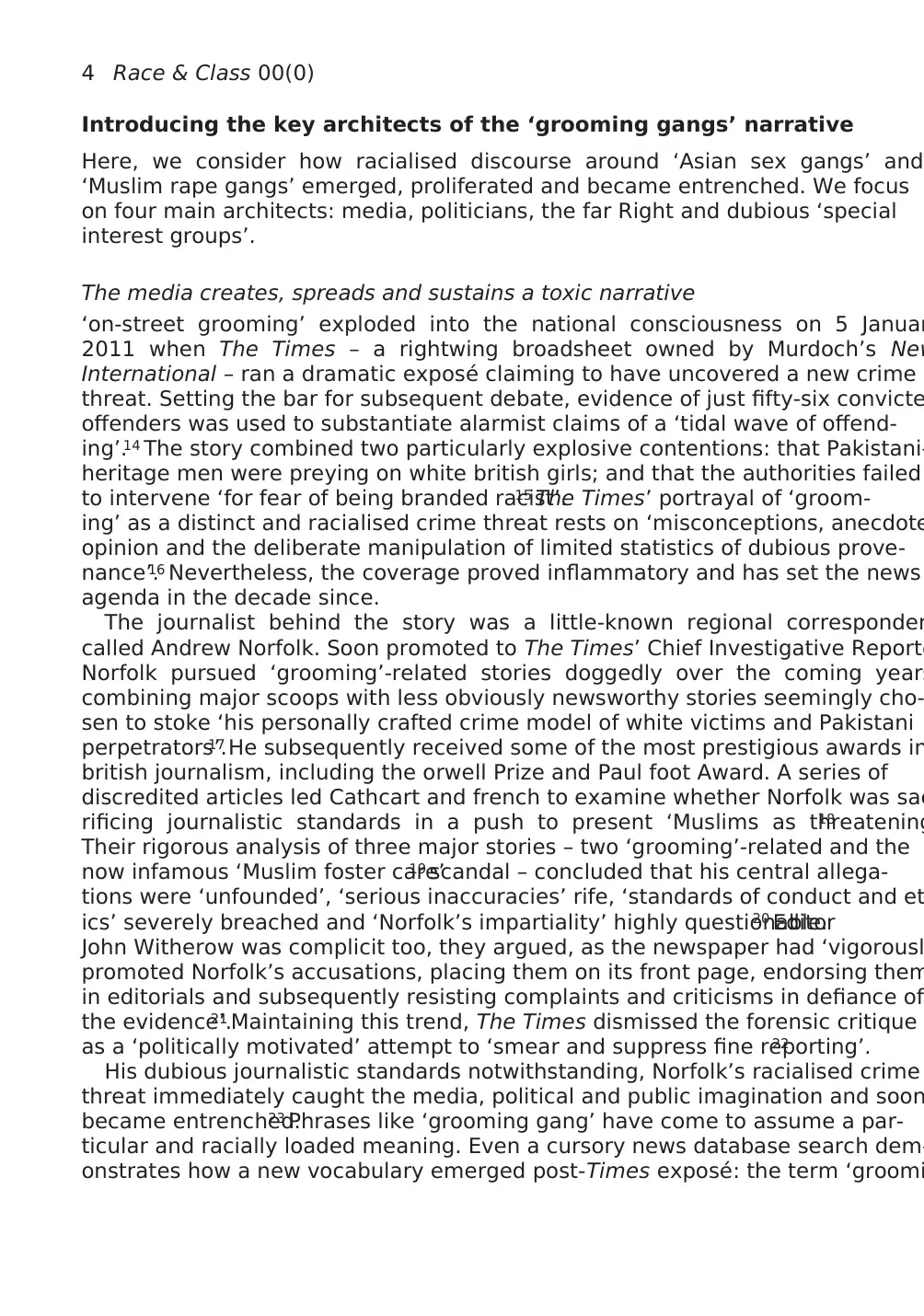
4 Race & Class 00(0)
Introducing the key architects of the ‘grooming gangs’ narrative
Here, we consider how racialised discourse around ‘Asian sex gangs’ and
‘Muslim rape gangs’ emerged, proliferated and became entrenched. We focus
on four main architects: media, politicians, the far Right and dubious ‘special
interest groups’.
The media creates, spreads and sustains a toxic narrative
‘on-street grooming’ exploded into the national consciousness on 5 Januar
2011 when The Times – a rightwing broadsheet owned by Murdoch’s New
International – ran a dramatic exposé claiming to have uncovered a new crime
threat. Setting the bar for subsequent debate, evidence of just fifty-six convicte
offenders was used to substantiate alarmist claims of a ‘tidal wave of offend-
ing’.14 The story combined two particularly explosive contentions: that Pakistani-
heritage men were preying on white british girls; and that the authorities failed
to intervene ‘for fear of being branded racist’.15 The Times’ portrayal of ‘groom-
ing’ as a distinct and racialised crime threat rests on ‘misconceptions, anecdote
opinion and the deliberate manipulation of limited statistics of dubious prove-
nance’.16 Nevertheless, the coverage proved inflammatory and has set the news
agenda in the decade since.
The journalist behind the story was a little-known regional corresponden
called Andrew Norfolk. Soon promoted to The Times’ Chief Investigative Reporte
Norfolk pursued ‘grooming’-related stories doggedly over the coming years
combining major scoops with less obviously newsworthy stories seemingly cho-
sen to stoke ‘his personally crafted crime model of white victims and Pakistani
perpetrators’.17 He subsequently received some of the most prestigious awards in
british journalism, including the orwell Prize and Paul foot Award. A series of
discredited articles led Cathcart and french to examine whether Norfolk was sac
rificing journalistic standards in a push to present ‘Muslims as threatening18
Their rigorous analysis of three major stories – two ‘grooming’-related and the
now infamous ‘Muslim foster care’19 scandal – concluded that his central allega-
tions were ‘unfounded’, ‘serious inaccuracies’ rife, ‘standards of conduct and et
ics’ severely breached and ‘Norfolk’s impartiality’ highly questionable.20 Editor
John Witherow was complicit too, they argued, as the newspaper had ‘vigorousl
promoted Norfolk’s accusations, placing them on its front page, endorsing them
in editorials and subsequently resisting complaints and criticisms in defiance of
the evidence’.21 Maintaining this trend, The Times dismissed the forensic critique
as a ‘politically motivated’ attempt to ‘smear and suppress fine reporting’.22
His dubious journalistic standards notwithstanding, Norfolk’s racialised crime
threat immediately caught the media, political and public imagination and soon
became entrenched.23 Phrases like ‘grooming gang’ have come to assume a par-
ticular and racially loaded meaning. Even a cursory news database search dem-
onstrates how a new vocabulary emerged post-Times exposé: the term ‘groomi
Introducing the key architects of the ‘grooming gangs’ narrative
Here, we consider how racialised discourse around ‘Asian sex gangs’ and
‘Muslim rape gangs’ emerged, proliferated and became entrenched. We focus
on four main architects: media, politicians, the far Right and dubious ‘special
interest groups’.
The media creates, spreads and sustains a toxic narrative
‘on-street grooming’ exploded into the national consciousness on 5 Januar
2011 when The Times – a rightwing broadsheet owned by Murdoch’s New
International – ran a dramatic exposé claiming to have uncovered a new crime
threat. Setting the bar for subsequent debate, evidence of just fifty-six convicte
offenders was used to substantiate alarmist claims of a ‘tidal wave of offend-
ing’.14 The story combined two particularly explosive contentions: that Pakistani-
heritage men were preying on white british girls; and that the authorities failed
to intervene ‘for fear of being branded racist’.15 The Times’ portrayal of ‘groom-
ing’ as a distinct and racialised crime threat rests on ‘misconceptions, anecdote
opinion and the deliberate manipulation of limited statistics of dubious prove-
nance’.16 Nevertheless, the coverage proved inflammatory and has set the news
agenda in the decade since.
The journalist behind the story was a little-known regional corresponden
called Andrew Norfolk. Soon promoted to The Times’ Chief Investigative Reporte
Norfolk pursued ‘grooming’-related stories doggedly over the coming years
combining major scoops with less obviously newsworthy stories seemingly cho-
sen to stoke ‘his personally crafted crime model of white victims and Pakistani
perpetrators’.17 He subsequently received some of the most prestigious awards in
british journalism, including the orwell Prize and Paul foot Award. A series of
discredited articles led Cathcart and french to examine whether Norfolk was sac
rificing journalistic standards in a push to present ‘Muslims as threatening18
Their rigorous analysis of three major stories – two ‘grooming’-related and the
now infamous ‘Muslim foster care’19 scandal – concluded that his central allega-
tions were ‘unfounded’, ‘serious inaccuracies’ rife, ‘standards of conduct and et
ics’ severely breached and ‘Norfolk’s impartiality’ highly questionable.20 Editor
John Witherow was complicit too, they argued, as the newspaper had ‘vigorousl
promoted Norfolk’s accusations, placing them on its front page, endorsing them
in editorials and subsequently resisting complaints and criticisms in defiance of
the evidence’.21 Maintaining this trend, The Times dismissed the forensic critique
as a ‘politically motivated’ attempt to ‘smear and suppress fine reporting’.22
His dubious journalistic standards notwithstanding, Norfolk’s racialised crime
threat immediately caught the media, political and public imagination and soon
became entrenched.23 Phrases like ‘grooming gang’ have come to assume a par-
ticular and racially loaded meaning. Even a cursory news database search dem-
onstrates how a new vocabulary emerged post-Times exposé: the term ‘groomi
Paraphrase This Document
Need a fresh take? Get an instant paraphrase of this document with our AI Paraphraser
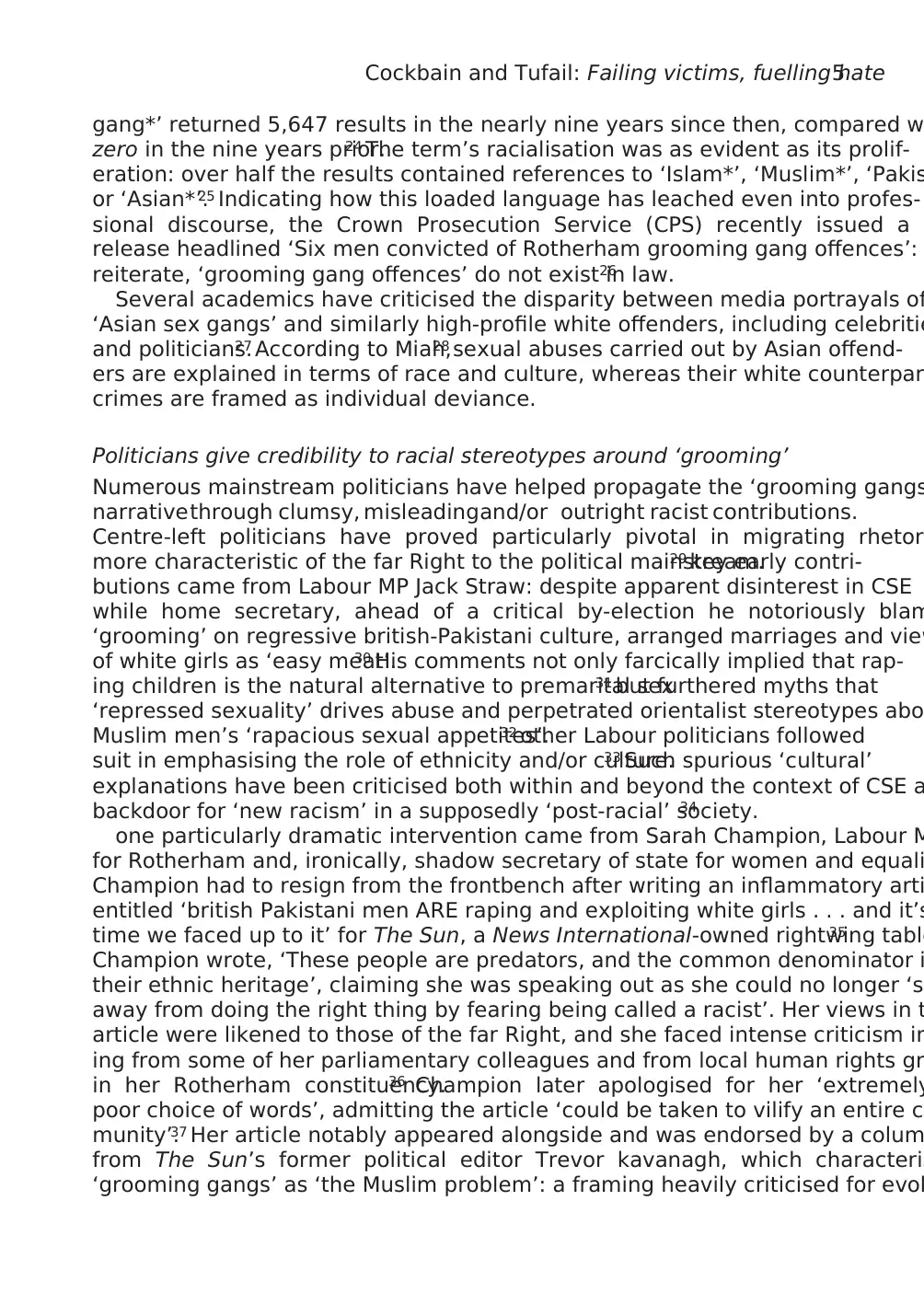
Cockbain and Tufail: Failing victims, fuelling hate5
gang*’ returned 5,647 results in the nearly nine years since then, compared w
zero in the nine years prior.24 The term’s racialisation was as evident as its prolif-
eration: over half the results contained references to ‘Islam*’, ‘Muslim*’, ‘Pakis
or ‘Asian*’.25 Indicating how this loaded language has leached even into profes-
sional discourse, the Crown Prosecution Service (CPS) recently issued a p
release headlined ‘Six men convicted of Rotherham grooming gang offences’:
reiterate, ‘grooming gang offences’ do not exist in law.26
Several academics have criticised the disparity between media portrayals of
‘Asian sex gangs’ and similarly high-profile white offenders, including celebritie
and politicians.27 According to Miah,28 sexual abuses carried out by Asian offend-
ers are explained in terms of race and culture, whereas their white counterpar
crimes are framed as individual deviance.
Politicians give credibility to racial stereotypes around ‘grooming’
Numerous mainstream politicians have helped propagate the ‘grooming gangs
narrative through clumsy, misleadingand/or outright racist contributions.
Centre-left politicians have proved particularly pivotal in migrating rhetori
more characteristic of the far Right to the political mainstream.29 key early contri-
butions came from Labour MP Jack Straw: despite apparent disinterest in CSE
while home secretary, ahead of a critical by-election he notoriously blam
‘grooming’ on regressive british-Pakistani culture, arranged marriages and view
of white girls as ‘easy meat’.30 His comments not only farcically implied that rap-
ing children is the natural alternative to premarital sex31 but furthered myths that
‘repressed sexuality’ drives abuse and perpetrated orientalist stereotypes abo
Muslim men’s ‘rapacious sexual appetites’.32 other Labour politicians followed
suit in emphasising the role of ethnicity and/or culture.33 Such spurious ‘cultural’
explanations have been criticised both within and beyond the context of CSE a
backdoor for ‘new racism’ in a supposedly ‘post-racial’ society.34
one particularly dramatic intervention came from Sarah Champion, Labour M
for Rotherham and, ironically, shadow secretary of state for women and equali
Champion had to resign from the frontbench after writing an inflammatory arti
entitled ‘british Pakistani men ARE raping and exploiting white girls . . . and it’s
time we faced up to it’ for The Sun, a News International-owned rightwing tablo35
Champion wrote, ‘These people are predators, and the common denominator i
their ethnic heritage’, claiming she was speaking out as she could no longer ‘sh
away from doing the right thing by fearing being called a racist’. Her views in t
article were likened to those of the far Right, and she faced intense criticism in
ing from some of her parliamentary colleagues and from local human rights gr
in her Rotherham constituency.36 Champion later apologised for her ‘extremely
poor choice of words’, admitting the article ‘could be taken to vilify an entire co
munity’.37 Her article notably appeared alongside and was endorsed by a colum
from The Sun’s former political editor Trevor kavanagh, which characteris
‘grooming gangs’ as ‘the Muslim problem’: a framing heavily criticised for evok
gang*’ returned 5,647 results in the nearly nine years since then, compared w
zero in the nine years prior.24 The term’s racialisation was as evident as its prolif-
eration: over half the results contained references to ‘Islam*’, ‘Muslim*’, ‘Pakis
or ‘Asian*’.25 Indicating how this loaded language has leached even into profes-
sional discourse, the Crown Prosecution Service (CPS) recently issued a p
release headlined ‘Six men convicted of Rotherham grooming gang offences’:
reiterate, ‘grooming gang offences’ do not exist in law.26
Several academics have criticised the disparity between media portrayals of
‘Asian sex gangs’ and similarly high-profile white offenders, including celebritie
and politicians.27 According to Miah,28 sexual abuses carried out by Asian offend-
ers are explained in terms of race and culture, whereas their white counterpar
crimes are framed as individual deviance.
Politicians give credibility to racial stereotypes around ‘grooming’
Numerous mainstream politicians have helped propagate the ‘grooming gangs
narrative through clumsy, misleadingand/or outright racist contributions.
Centre-left politicians have proved particularly pivotal in migrating rhetori
more characteristic of the far Right to the political mainstream.29 key early contri-
butions came from Labour MP Jack Straw: despite apparent disinterest in CSE
while home secretary, ahead of a critical by-election he notoriously blam
‘grooming’ on regressive british-Pakistani culture, arranged marriages and view
of white girls as ‘easy meat’.30 His comments not only farcically implied that rap-
ing children is the natural alternative to premarital sex31 but furthered myths that
‘repressed sexuality’ drives abuse and perpetrated orientalist stereotypes abo
Muslim men’s ‘rapacious sexual appetites’.32 other Labour politicians followed
suit in emphasising the role of ethnicity and/or culture.33 Such spurious ‘cultural’
explanations have been criticised both within and beyond the context of CSE a
backdoor for ‘new racism’ in a supposedly ‘post-racial’ society.34
one particularly dramatic intervention came from Sarah Champion, Labour M
for Rotherham and, ironically, shadow secretary of state for women and equali
Champion had to resign from the frontbench after writing an inflammatory arti
entitled ‘british Pakistani men ARE raping and exploiting white girls . . . and it’s
time we faced up to it’ for The Sun, a News International-owned rightwing tablo35
Champion wrote, ‘These people are predators, and the common denominator i
their ethnic heritage’, claiming she was speaking out as she could no longer ‘sh
away from doing the right thing by fearing being called a racist’. Her views in t
article were likened to those of the far Right, and she faced intense criticism in
ing from some of her parliamentary colleagues and from local human rights gr
in her Rotherham constituency.36 Champion later apologised for her ‘extremely
poor choice of words’, admitting the article ‘could be taken to vilify an entire co
munity’.37 Her article notably appeared alongside and was endorsed by a colum
from The Sun’s former political editor Trevor kavanagh, which characteris
‘grooming gangs’ as ‘the Muslim problem’: a framing heavily criticised for evok
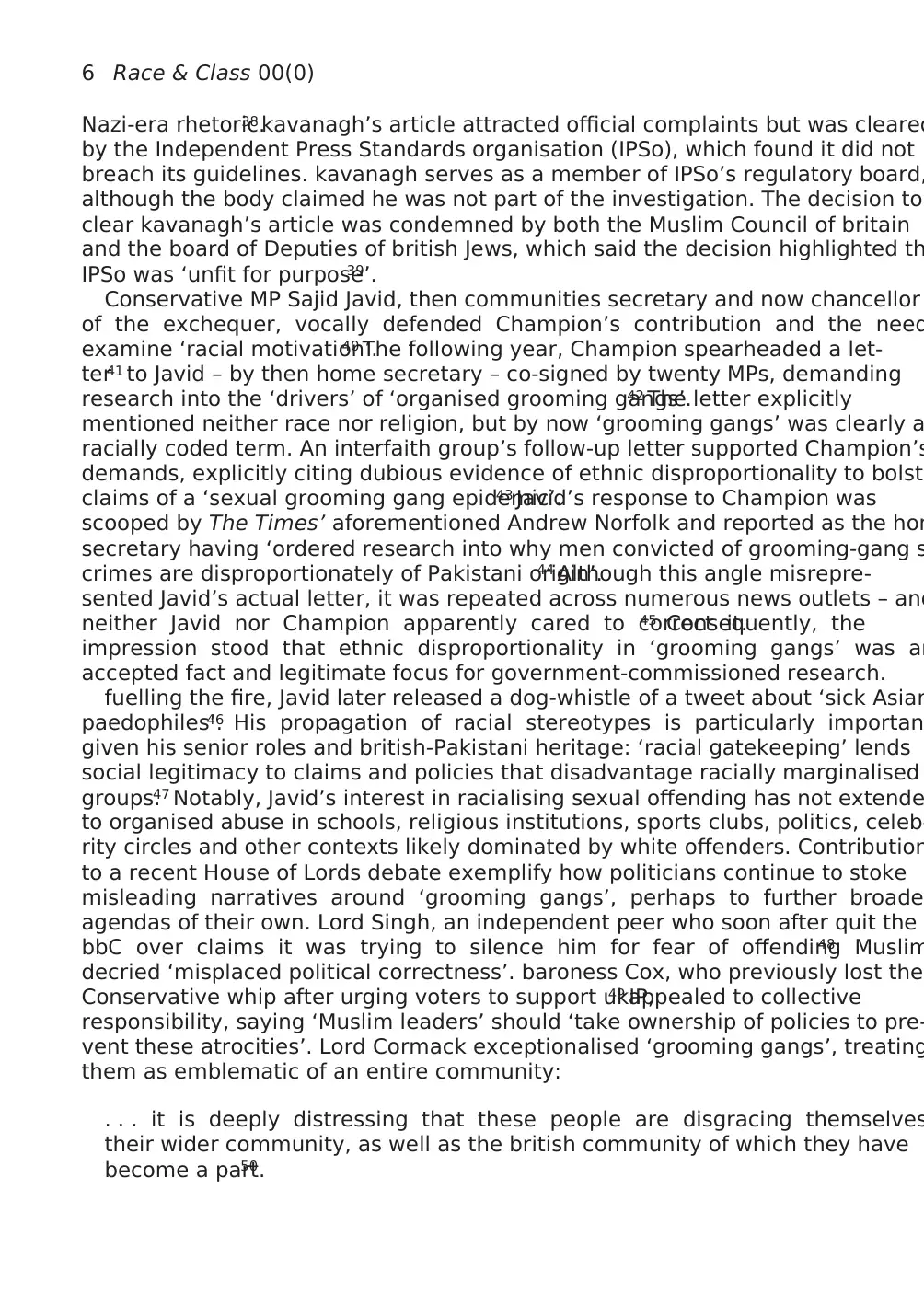
6 Race & Class 00(0)
Nazi-era rhetoric.38 kavanagh’s article attracted official complaints but was cleared
by the Independent Press Standards organisation (IPSo), which found it did not
breach its guidelines. kavanagh serves as a member of IPSo’s regulatory board,
although the body claimed he was not part of the investigation. The decision to
clear kavanagh’s article was condemned by both the Muslim Council of britain
and the board of Deputies of british Jews, which said the decision highlighted th
IPSo was ‘unfit for purpose’.39
Conservative MP Sajid Javid, then communities secretary and now chancellor
of the exchequer, vocally defended Champion’s contribution and the need
examine ‘racial motivation’.40 The following year, Champion spearheaded a let-
ter41 to Javid – by then home secretary – co-signed by twenty MPs, demanding
research into the ‘drivers’ of ‘organised grooming gangs’.42 The letter explicitly
mentioned neither race nor religion, but by now ‘grooming gangs’ was clearly a
racially coded term. An interfaith group’s follow-up letter supported Champion’s
demands, explicitly citing dubious evidence of ethnic disproportionality to bolste
claims of a ‘sexual grooming gang epidemic’.43 Javid’s response to Champion was
scooped by The Times’ aforementioned Andrew Norfolk and reported as the hom
secretary having ‘ordered research into why men convicted of grooming-gang s
crimes are disproportionately of Pakistani origin’.44 Although this angle misrepre-
sented Javid’s actual letter, it was repeated across numerous news outlets – and
neither Javid nor Champion apparently cared to correct it.45 Consequently, the
impression stood that ethnic disproportionality in ‘grooming gangs’ was an
accepted fact and legitimate focus for government-commissioned research.
fuelling the fire, Javid later released a dog-whistle of a tweet about ‘sick Asian
paedophiles’.46 His propagation of racial stereotypes is particularly importan
given his senior roles and british-Pakistani heritage: ‘racial gatekeeping’ lends
social legitimacy to claims and policies that disadvantage racially marginalised
groups.47 Notably, Javid’s interest in racialising sexual offending has not extende
to organised abuse in schools, religious institutions, sports clubs, politics, celeb-
rity circles and other contexts likely dominated by white offenders. Contribution
to a recent House of Lords debate exemplify how politicians continue to stoke
misleading narratives around ‘grooming gangs’, perhaps to further broade
agendas of their own. Lord Singh, an independent peer who soon after quit the
bbC over claims it was trying to silence him for fear of offending Muslim48
decried ‘misplaced political correctness’. baroness Cox, who previously lost the
Conservative whip after urging voters to support ukIP,49 appealed to collective
responsibility, saying ‘Muslim leaders’ should ‘take ownership of policies to pre-
vent these atrocities’. Lord Cormack exceptionalised ‘grooming gangs’, treating
them as emblematic of an entire community:
. . . it is deeply distressing that these people are disgracing themselves
their wider community, as well as the british community of which they have
become a part.50
Nazi-era rhetoric.38 kavanagh’s article attracted official complaints but was cleared
by the Independent Press Standards organisation (IPSo), which found it did not
breach its guidelines. kavanagh serves as a member of IPSo’s regulatory board,
although the body claimed he was not part of the investigation. The decision to
clear kavanagh’s article was condemned by both the Muslim Council of britain
and the board of Deputies of british Jews, which said the decision highlighted th
IPSo was ‘unfit for purpose’.39
Conservative MP Sajid Javid, then communities secretary and now chancellor
of the exchequer, vocally defended Champion’s contribution and the need
examine ‘racial motivation’.40 The following year, Champion spearheaded a let-
ter41 to Javid – by then home secretary – co-signed by twenty MPs, demanding
research into the ‘drivers’ of ‘organised grooming gangs’.42 The letter explicitly
mentioned neither race nor religion, but by now ‘grooming gangs’ was clearly a
racially coded term. An interfaith group’s follow-up letter supported Champion’s
demands, explicitly citing dubious evidence of ethnic disproportionality to bolste
claims of a ‘sexual grooming gang epidemic’.43 Javid’s response to Champion was
scooped by The Times’ aforementioned Andrew Norfolk and reported as the hom
secretary having ‘ordered research into why men convicted of grooming-gang s
crimes are disproportionately of Pakistani origin’.44 Although this angle misrepre-
sented Javid’s actual letter, it was repeated across numerous news outlets – and
neither Javid nor Champion apparently cared to correct it.45 Consequently, the
impression stood that ethnic disproportionality in ‘grooming gangs’ was an
accepted fact and legitimate focus for government-commissioned research.
fuelling the fire, Javid later released a dog-whistle of a tweet about ‘sick Asian
paedophiles’.46 His propagation of racial stereotypes is particularly importan
given his senior roles and british-Pakistani heritage: ‘racial gatekeeping’ lends
social legitimacy to claims and policies that disadvantage racially marginalised
groups.47 Notably, Javid’s interest in racialising sexual offending has not extende
to organised abuse in schools, religious institutions, sports clubs, politics, celeb-
rity circles and other contexts likely dominated by white offenders. Contribution
to a recent House of Lords debate exemplify how politicians continue to stoke
misleading narratives around ‘grooming gangs’, perhaps to further broade
agendas of their own. Lord Singh, an independent peer who soon after quit the
bbC over claims it was trying to silence him for fear of offending Muslim48
decried ‘misplaced political correctness’. baroness Cox, who previously lost the
Conservative whip after urging voters to support ukIP,49 appealed to collective
responsibility, saying ‘Muslim leaders’ should ‘take ownership of policies to pre-
vent these atrocities’. Lord Cormack exceptionalised ‘grooming gangs’, treating
them as emblematic of an entire community:
. . . it is deeply distressing that these people are disgracing themselves
their wider community, as well as the british community of which they have
become a part.50
⊘ This is a preview!⊘
Do you want full access?
Subscribe today to unlock all pages.

Trusted by 1+ million students worldwide
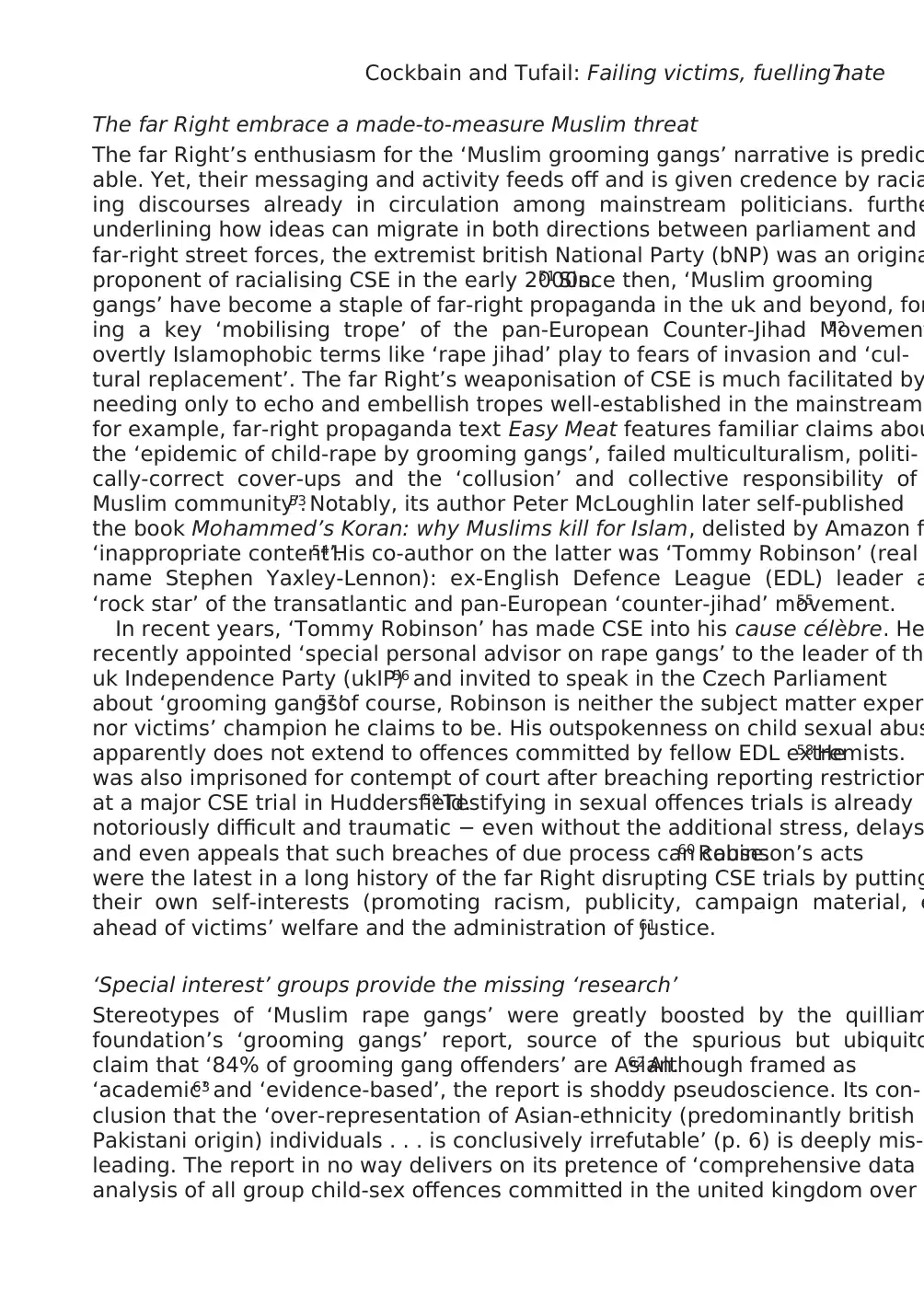
Cockbain and Tufail: Failing victims, fuelling hate7
The far Right embrace a made-to-measure Muslim threat
The far Right’s enthusiasm for the ‘Muslim grooming gangs’ narrative is predic
able. Yet, their messaging and activity feeds off and is given credence by racia
ing discourses already in circulation among mainstream politicians. furthe
underlining how ideas can migrate in both directions between parliament and
far-right street forces, the extremist british National Party (bNP) was an origina
proponent of racialising CSE in the early 2000s.51 Since then, ‘Muslim grooming
gangs’ have become a staple of far-right propaganda in the uk and beyond, for
ing a key ‘mobilising trope’ of the pan-European Counter-Jihad Movement52
overtly Islamophobic terms like ‘rape jihad’ play to fears of invasion and ‘cul-
tural replacement’. The far Right’s weaponisation of CSE is much facilitated by
needing only to echo and embellish tropes well-established in the mainstream.
for example, far-right propaganda text Easy Meat features familiar claims abou
the ‘epidemic of child-rape by grooming gangs’, failed multiculturalism, politi-
cally-correct cover-ups and the ‘collusion’ and collective responsibility of
Muslim community’.53 Notably, its author Peter McLoughlin later self-published
the book Mohammed’s Koran: why Muslims kill for Islam, delisted by Amazon f
‘inappropriate content’.54 His co-author on the latter was ‘Tommy Robinson’ (real
name Stephen Yaxley-Lennon): ex-English Defence League (EDL) leader a
‘rock star’ of the transatlantic and pan-European ‘counter-jihad’ movement.55
In recent years, ‘Tommy Robinson’ has made CSE into his cause célèbre. He
recently appointed ‘special personal advisor on rape gangs’ to the leader of the
uk Independence Party (ukIP)56 and invited to speak in the Czech Parliament
about ‘grooming gangs’.57 of course, Robinson is neither the subject matter expert
nor victims’ champion he claims to be. His outspokenness on child sexual abus
apparently does not extend to offences committed by fellow EDL extremists.58 He
was also imprisoned for contempt of court after breaching reporting restriction
at a major CSE trial in Huddersfield.59 Testifying in sexual offences trials is already
notoriously difficult and traumatic − even without the additional stress, delays
and even appeals that such breaches of due process can cause.60 Robinson’s acts
were the latest in a long history of the far Right disrupting CSE trials by putting
their own self-interests (promoting racism, publicity, campaign material, e
ahead of victims’ welfare and the administration of justice.61
‘Special interest’ groups provide the missing ‘research’
Stereotypes of ‘Muslim rape gangs’ were greatly boosted by the quilliam
foundation’s ‘grooming gangs’ report, source of the spurious but ubiquito
claim that ‘84% of grooming gang offenders’ are Asian.62 Although framed as
‘academic’63 and ‘evidence-based’, the report is shoddy pseudoscience. Its con-
clusion that the ‘over-representation of Asian-ethnicity (predominantly british
Pakistani origin) individuals . . . is conclusively irrefutable’ (p. 6) is deeply mis-
leading. The report in no way delivers on its pretence of ‘comprehensive data
analysis of all group child-sex offences committed in the united kingdom over
The far Right embrace a made-to-measure Muslim threat
The far Right’s enthusiasm for the ‘Muslim grooming gangs’ narrative is predic
able. Yet, their messaging and activity feeds off and is given credence by racia
ing discourses already in circulation among mainstream politicians. furthe
underlining how ideas can migrate in both directions between parliament and
far-right street forces, the extremist british National Party (bNP) was an origina
proponent of racialising CSE in the early 2000s.51 Since then, ‘Muslim grooming
gangs’ have become a staple of far-right propaganda in the uk and beyond, for
ing a key ‘mobilising trope’ of the pan-European Counter-Jihad Movement52
overtly Islamophobic terms like ‘rape jihad’ play to fears of invasion and ‘cul-
tural replacement’. The far Right’s weaponisation of CSE is much facilitated by
needing only to echo and embellish tropes well-established in the mainstream.
for example, far-right propaganda text Easy Meat features familiar claims abou
the ‘epidemic of child-rape by grooming gangs’, failed multiculturalism, politi-
cally-correct cover-ups and the ‘collusion’ and collective responsibility of
Muslim community’.53 Notably, its author Peter McLoughlin later self-published
the book Mohammed’s Koran: why Muslims kill for Islam, delisted by Amazon f
‘inappropriate content’.54 His co-author on the latter was ‘Tommy Robinson’ (real
name Stephen Yaxley-Lennon): ex-English Defence League (EDL) leader a
‘rock star’ of the transatlantic and pan-European ‘counter-jihad’ movement.55
In recent years, ‘Tommy Robinson’ has made CSE into his cause célèbre. He
recently appointed ‘special personal advisor on rape gangs’ to the leader of the
uk Independence Party (ukIP)56 and invited to speak in the Czech Parliament
about ‘grooming gangs’.57 of course, Robinson is neither the subject matter expert
nor victims’ champion he claims to be. His outspokenness on child sexual abus
apparently does not extend to offences committed by fellow EDL extremists.58 He
was also imprisoned for contempt of court after breaching reporting restriction
at a major CSE trial in Huddersfield.59 Testifying in sexual offences trials is already
notoriously difficult and traumatic − even without the additional stress, delays
and even appeals that such breaches of due process can cause.60 Robinson’s acts
were the latest in a long history of the far Right disrupting CSE trials by putting
their own self-interests (promoting racism, publicity, campaign material, e
ahead of victims’ welfare and the administration of justice.61
‘Special interest’ groups provide the missing ‘research’
Stereotypes of ‘Muslim rape gangs’ were greatly boosted by the quilliam
foundation’s ‘grooming gangs’ report, source of the spurious but ubiquito
claim that ‘84% of grooming gang offenders’ are Asian.62 Although framed as
‘academic’63 and ‘evidence-based’, the report is shoddy pseudoscience. Its con-
clusion that the ‘over-representation of Asian-ethnicity (predominantly british
Pakistani origin) individuals . . . is conclusively irrefutable’ (p. 6) is deeply mis-
leading. The report in no way delivers on its pretence of ‘comprehensive data
analysis of all group child-sex offences committed in the united kingdom over
Paraphrase This Document
Need a fresh take? Get an instant paraphrase of this document with our AI Paraphraser
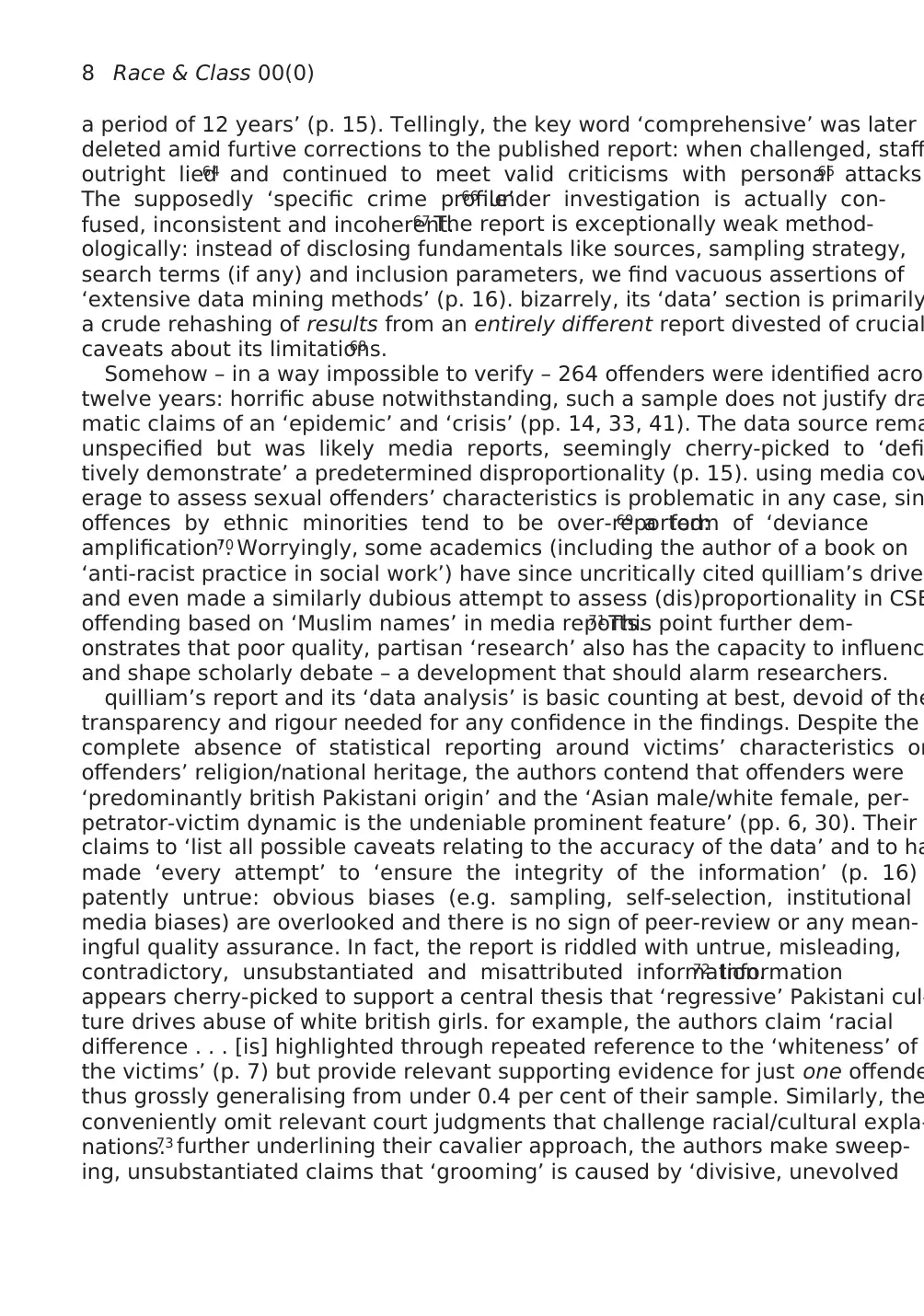
8 Race & Class 00(0)
a period of 12 years’ (p. 15). Tellingly, the key word ‘comprehensive’ was later
deleted amid furtive corrections to the published report: when challenged, staff
outright lied64 and continued to meet valid criticisms with personal attacks.65
The supposedly ‘specific crime profile’66 under investigation is actually con-
fused, inconsistent and incoherent.67 The report is exceptionally weak method-
ologically: instead of disclosing fundamentals like sources, sampling strategy,
search terms (if any) and inclusion parameters, we find vacuous assertions of
‘extensive data mining methods’ (p. 16). bizarrely, its ‘data’ section is primarily
a crude rehashing of results from an entirely different report divested of crucial
caveats about its limitations.68
Somehow – in a way impossible to verify – 264 offenders were identified acros
twelve years: horrific abuse notwithstanding, such a sample does not justify dra
matic claims of an ‘epidemic’ and ‘crisis’ (pp. 14, 33, 41). The data source rema
unspecified but was likely media reports, seemingly cherry-picked to ‘defi
tively demonstrate’ a predetermined disproportionality (p. 15). using media cov
erage to assess sexual offenders’ characteristics is problematic in any case, sin
offences by ethnic minorities tend to be over-reported:69 a form of ‘deviance
amplification’.70 Worryingly, some academics (including the author of a book on
‘anti-racist practice in social work’) have since uncritically cited quilliam’s drivel
and even made a similarly dubious attempt to assess (dis)proportionality in CSE
offending based on ‘Muslim names’ in media reports.71 This point further dem-
onstrates that poor quality, partisan ‘research’ also has the capacity to influenc
and shape scholarly debate – a development that should alarm researchers.
quilliam’s report and its ‘data analysis’ is basic counting at best, devoid of the
transparency and rigour needed for any confidence in the findings. Despite the
complete absence of statistical reporting around victims’ characteristics or
offenders’ religion/national heritage, the authors contend that offenders were
‘predominantly british Pakistani origin’ and the ‘Asian male/white female, per-
petrator-victim dynamic is the undeniable prominent feature’ (pp. 6, 30). Their
claims to ‘list all possible caveats relating to the accuracy of the data’ and to ha
made ‘every attempt’ to ‘ensure the integrity of the information’ (p. 16)
patently untrue: obvious biases (e.g. sampling, self-selection, institutional
media biases) are overlooked and there is no sign of peer-review or any mean-
ingful quality assurance. In fact, the report is riddled with untrue, misleading,
contradictory, unsubstantiated and misattributed information.72 Information
appears cherry-picked to support a central thesis that ‘regressive’ Pakistani cul-
ture drives abuse of white british girls. for example, the authors claim ‘racial
difference . . . [is] highlighted through repeated reference to the ‘whiteness’ of
the victims’ (p. 7) but provide relevant supporting evidence for just one offende
thus grossly generalising from under 0.4 per cent of their sample. Similarly, the
conveniently omit relevant court judgments that challenge racial/cultural expla-
nations.73 further underlining their cavalier approach, the authors make sweep-
ing, unsubstantiated claims that ‘grooming’ is caused by ‘divisive, unevolved
a period of 12 years’ (p. 15). Tellingly, the key word ‘comprehensive’ was later
deleted amid furtive corrections to the published report: when challenged, staff
outright lied64 and continued to meet valid criticisms with personal attacks.65
The supposedly ‘specific crime profile’66 under investigation is actually con-
fused, inconsistent and incoherent.67 The report is exceptionally weak method-
ologically: instead of disclosing fundamentals like sources, sampling strategy,
search terms (if any) and inclusion parameters, we find vacuous assertions of
‘extensive data mining methods’ (p. 16). bizarrely, its ‘data’ section is primarily
a crude rehashing of results from an entirely different report divested of crucial
caveats about its limitations.68
Somehow – in a way impossible to verify – 264 offenders were identified acros
twelve years: horrific abuse notwithstanding, such a sample does not justify dra
matic claims of an ‘epidemic’ and ‘crisis’ (pp. 14, 33, 41). The data source rema
unspecified but was likely media reports, seemingly cherry-picked to ‘defi
tively demonstrate’ a predetermined disproportionality (p. 15). using media cov
erage to assess sexual offenders’ characteristics is problematic in any case, sin
offences by ethnic minorities tend to be over-reported:69 a form of ‘deviance
amplification’.70 Worryingly, some academics (including the author of a book on
‘anti-racist practice in social work’) have since uncritically cited quilliam’s drivel
and even made a similarly dubious attempt to assess (dis)proportionality in CSE
offending based on ‘Muslim names’ in media reports.71 This point further dem-
onstrates that poor quality, partisan ‘research’ also has the capacity to influenc
and shape scholarly debate – a development that should alarm researchers.
quilliam’s report and its ‘data analysis’ is basic counting at best, devoid of the
transparency and rigour needed for any confidence in the findings. Despite the
complete absence of statistical reporting around victims’ characteristics or
offenders’ religion/national heritage, the authors contend that offenders were
‘predominantly british Pakistani origin’ and the ‘Asian male/white female, per-
petrator-victim dynamic is the undeniable prominent feature’ (pp. 6, 30). Their
claims to ‘list all possible caveats relating to the accuracy of the data’ and to ha
made ‘every attempt’ to ‘ensure the integrity of the information’ (p. 16)
patently untrue: obvious biases (e.g. sampling, self-selection, institutional
media biases) are overlooked and there is no sign of peer-review or any mean-
ingful quality assurance. In fact, the report is riddled with untrue, misleading,
contradictory, unsubstantiated and misattributed information.72 Information
appears cherry-picked to support a central thesis that ‘regressive’ Pakistani cul-
ture drives abuse of white british girls. for example, the authors claim ‘racial
difference . . . [is] highlighted through repeated reference to the ‘whiteness’ of
the victims’ (p. 7) but provide relevant supporting evidence for just one offende
thus grossly generalising from under 0.4 per cent of their sample. Similarly, the
conveniently omit relevant court judgments that challenge racial/cultural expla-
nations.73 further underlining their cavalier approach, the authors make sweep-
ing, unsubstantiated claims that ‘grooming’ is caused by ‘divisive, unevolved
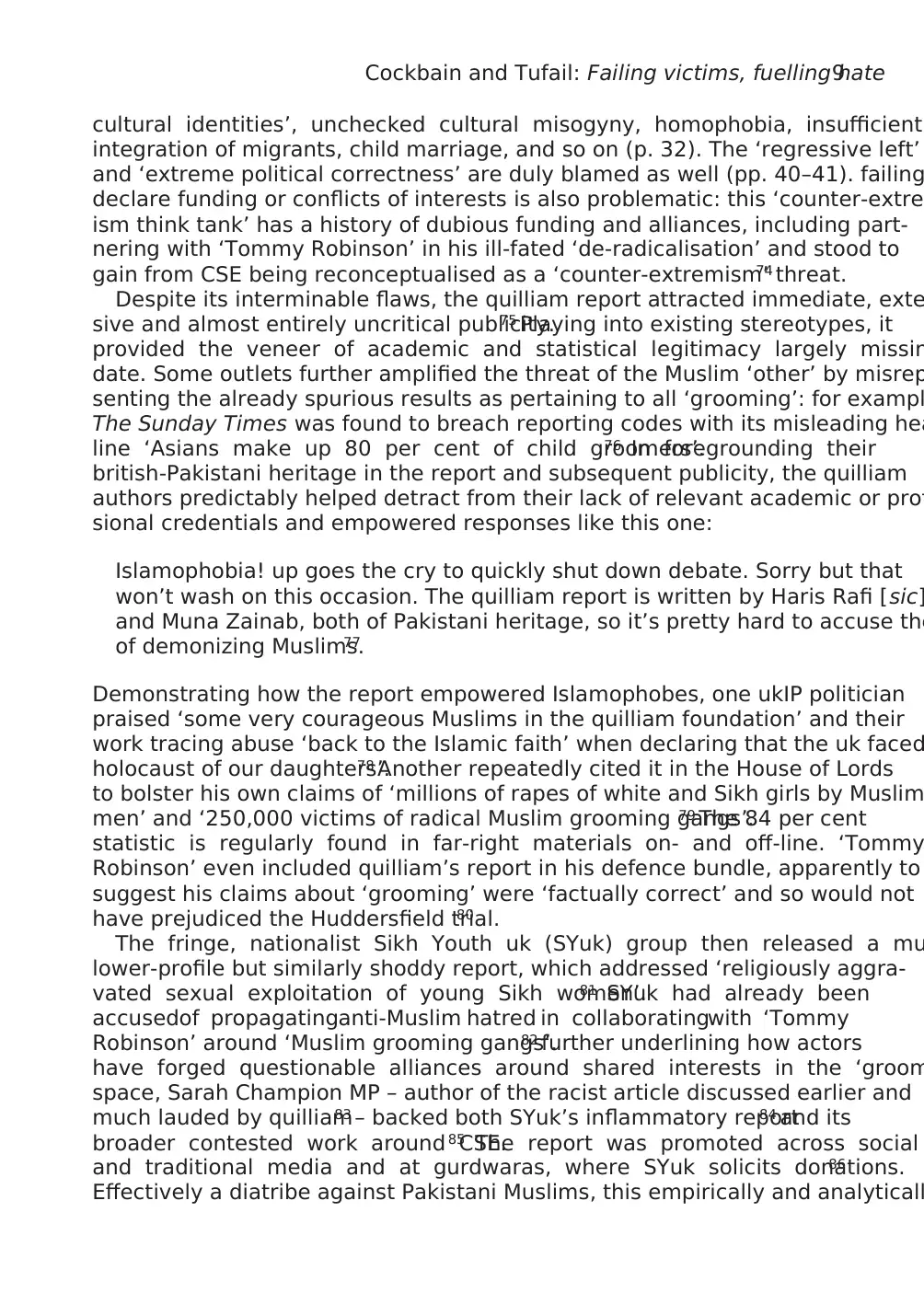
Cockbain and Tufail: Failing victims, fuelling hate9
cultural identities’, unchecked cultural misogyny, homophobia, insufficient
integration of migrants, child marriage, and so on (p. 32). The ‘regressive left’
and ‘extreme political correctness’ are duly blamed as well (pp. 40–41). failing
declare funding or conflicts of interests is also problematic: this ‘counter-extrem
ism think tank’ has a history of dubious funding and alliances, including part-
nering with ‘Tommy Robinson’ in his ill-fated ‘de-radicalisation’ and stood to
gain from CSE being reconceptualised as a ‘counter-extremism’ threat.74
Despite its interminable flaws, the quilliam report attracted immediate, exte
sive and almost entirely uncritical publicity.75 Playing into existing stereotypes, it
provided the veneer of academic and statistical legitimacy largely missin
date. Some outlets further amplified the threat of the Muslim ‘other’ by misrep
senting the already spurious results as pertaining to all ‘grooming’: for exampl
The Sunday Times was found to breach reporting codes with its misleading hea
line ‘Asians make up 80 per cent of child groomers’.76 In foregrounding their
british-Pakistani heritage in the report and subsequent publicity, the quilliam
authors predictably helped detract from their lack of relevant academic or prof
sional credentials and empowered responses like this one:
Islamophobia! up goes the cry to quickly shut down debate. Sorry but that
won’t wash on this occasion. The quilliam report is written by Haris Rafi [sic]
and Muna Zainab, both of Pakistani heritage, so it’s pretty hard to accuse the
of demonizing Muslims.77
Demonstrating how the report empowered Islamophobes, one ukIP politician
praised ‘some very courageous Muslims in the quilliam foundation’ and their
work tracing abuse ‘back to the Islamic faith’ when declaring that the uk faced
holocaust of our daughters’.78 Another repeatedly cited it in the House of Lords
to bolster his own claims of ‘millions of rapes of white and Sikh girls by Muslim
men’ and ‘250,000 victims of radical Muslim grooming gangs’.79 The 84 per cent
statistic is regularly found in far-right materials on- and off-line. ‘Tommy
Robinson’ even included quilliam’s report in his defence bundle, apparently to
suggest his claims about ‘grooming’ were ‘factually correct’ and so would not
have prejudiced the Huddersfield trial.80
The fringe, nationalist Sikh Youth uk (SYuk) group then released a mu
lower-profile but similarly shoddy report, which addressed ‘religiously aggra-
vated sexual exploitation of young Sikh women’.81 SYuk had already been
accusedof propagatinganti-Muslim hatred in collaboratingwith ‘Tommy
Robinson’ around ‘Muslim grooming gangs’.82 further underlining how actors
have forged questionable alliances around shared interests in the ‘groom
space, Sarah Champion MP – author of the racist article discussed earlier and
much lauded by quilliam83 – backed both SYuk’s inflammatory report84 and its
broader contested work around CSE.85 The report was promoted across social
and traditional media and at gurdwaras, where SYuk solicits donations.86
Effectively a diatribe against Pakistani Muslims, this empirically and analyticall
cultural identities’, unchecked cultural misogyny, homophobia, insufficient
integration of migrants, child marriage, and so on (p. 32). The ‘regressive left’
and ‘extreme political correctness’ are duly blamed as well (pp. 40–41). failing
declare funding or conflicts of interests is also problematic: this ‘counter-extrem
ism think tank’ has a history of dubious funding and alliances, including part-
nering with ‘Tommy Robinson’ in his ill-fated ‘de-radicalisation’ and stood to
gain from CSE being reconceptualised as a ‘counter-extremism’ threat.74
Despite its interminable flaws, the quilliam report attracted immediate, exte
sive and almost entirely uncritical publicity.75 Playing into existing stereotypes, it
provided the veneer of academic and statistical legitimacy largely missin
date. Some outlets further amplified the threat of the Muslim ‘other’ by misrep
senting the already spurious results as pertaining to all ‘grooming’: for exampl
The Sunday Times was found to breach reporting codes with its misleading hea
line ‘Asians make up 80 per cent of child groomers’.76 In foregrounding their
british-Pakistani heritage in the report and subsequent publicity, the quilliam
authors predictably helped detract from their lack of relevant academic or prof
sional credentials and empowered responses like this one:
Islamophobia! up goes the cry to quickly shut down debate. Sorry but that
won’t wash on this occasion. The quilliam report is written by Haris Rafi [sic]
and Muna Zainab, both of Pakistani heritage, so it’s pretty hard to accuse the
of demonizing Muslims.77
Demonstrating how the report empowered Islamophobes, one ukIP politician
praised ‘some very courageous Muslims in the quilliam foundation’ and their
work tracing abuse ‘back to the Islamic faith’ when declaring that the uk faced
holocaust of our daughters’.78 Another repeatedly cited it in the House of Lords
to bolster his own claims of ‘millions of rapes of white and Sikh girls by Muslim
men’ and ‘250,000 victims of radical Muslim grooming gangs’.79 The 84 per cent
statistic is regularly found in far-right materials on- and off-line. ‘Tommy
Robinson’ even included quilliam’s report in his defence bundle, apparently to
suggest his claims about ‘grooming’ were ‘factually correct’ and so would not
have prejudiced the Huddersfield trial.80
The fringe, nationalist Sikh Youth uk (SYuk) group then released a mu
lower-profile but similarly shoddy report, which addressed ‘religiously aggra-
vated sexual exploitation of young Sikh women’.81 SYuk had already been
accusedof propagatinganti-Muslim hatred in collaboratingwith ‘Tommy
Robinson’ around ‘Muslim grooming gangs’.82 further underlining how actors
have forged questionable alliances around shared interests in the ‘groom
space, Sarah Champion MP – author of the racist article discussed earlier and
much lauded by quilliam83 – backed both SYuk’s inflammatory report84 and its
broader contested work around CSE.85 The report was promoted across social
and traditional media and at gurdwaras, where SYuk solicits donations.86
Effectively a diatribe against Pakistani Muslims, this empirically and analyticall
⊘ This is a preview!⊘
Do you want full access?
Subscribe today to unlock all pages.

Trusted by 1+ million students worldwide
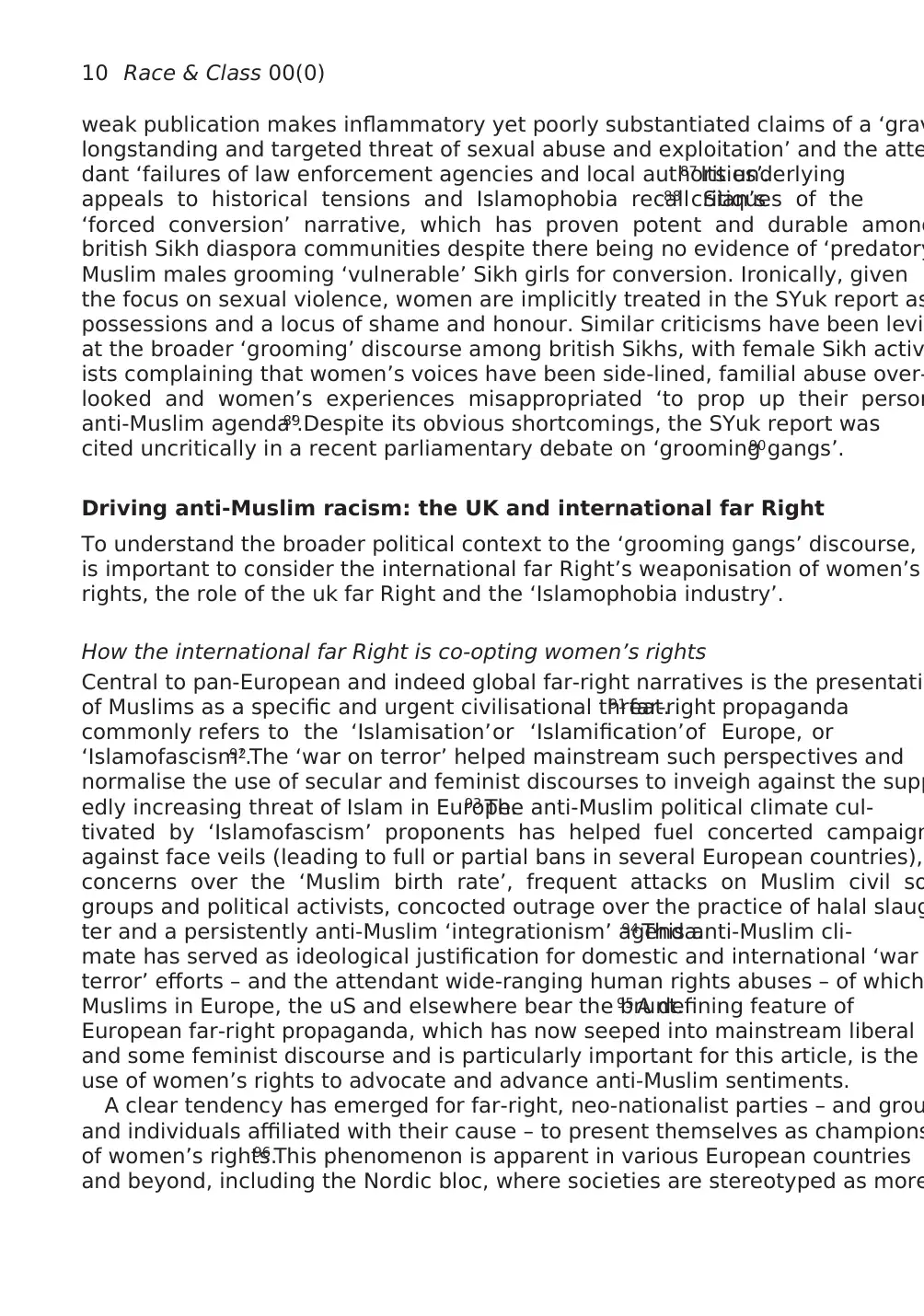
10 Race & Class 00(0)
weak publication makes inflammatory yet poorly substantiated claims of a ‘grav
longstanding and targeted threat of sexual abuse and exploitation’ and the atte
dant ‘failures of law enforcement agencies and local authorities’.87 Its underlying
appeals to historical tensions and Islamophobia recall Sian’s88 critiques of the
‘forced conversion’ narrative, which has proven potent and durable among
british Sikh diaspora communities despite there being no evidence of ‘predatory
Muslim males grooming ‘vulnerable’ Sikh girls for conversion. Ironically, given
the focus on sexual violence, women are implicitly treated in the SYuk report as
possessions and a locus of shame and honour. Similar criticisms have been levie
at the broader ‘grooming’ discourse among british Sikhs, with female Sikh activ
ists complaining that women’s voices have been side-lined, familial abuse over-
looked and women’s experiences misappropriated ‘to prop up their person
anti-Muslim agenda’.89 Despite its obvious shortcomings, the SYuk report was
cited uncritically in a recent parliamentary debate on ‘grooming gangs’.90
Driving anti-Muslim racism: the UK and international far Right
To understand the broader political context to the ‘grooming gangs’ discourse, i
is important to consider the international far Right’s weaponisation of women’s
rights, the role of the uk far Right and the ‘Islamophobia industry’.
How the international far Right is co-opting women’s rights
Central to pan-European and indeed global far-right narratives is the presentatio
of Muslims as a specific and urgent civilisational threat.91 far-right propaganda
commonly refers to the ‘Islamisation’ or ‘Islamification’ of Europe, or
‘Islamofascism’.92 The ‘war on terror’ helped mainstream such perspectives and
normalise the use of secular and feminist discourses to inveigh against the supp
edly increasing threat of Islam in Europe.93 The anti-Muslim political climate cul-
tivated by ‘Islamofascism’ proponents has helped fuel concerted campaign
against face veils (leading to full or partial bans in several European countries),
concerns over the ‘Muslim birth rate’, frequent attacks on Muslim civil so
groups and political activists, concocted outrage over the practice of halal slaug
ter and a persistently anti-Muslim ‘integrationism’ agenda.94 This anti-Muslim cli-
mate has served as ideological justification for domestic and international ‘war
terror’ efforts – and the attendant wide-ranging human rights abuses – of which
Muslims in Europe, the uS and elsewhere bear the brunt.95 A defining feature of
European far-right propaganda, which has now seeped into mainstream liberal
and some feminist discourse and is particularly important for this article, is the
use of women’s rights to advocate and advance anti-Muslim sentiments.
A clear tendency has emerged for far-right, neo-nationalist parties – and grou
and individuals affiliated with their cause – to present themselves as champions
of women’s rights.96 This phenomenon is apparent in various European countries
and beyond, including the Nordic bloc, where societies are stereotyped as more
weak publication makes inflammatory yet poorly substantiated claims of a ‘grav
longstanding and targeted threat of sexual abuse and exploitation’ and the atte
dant ‘failures of law enforcement agencies and local authorities’.87 Its underlying
appeals to historical tensions and Islamophobia recall Sian’s88 critiques of the
‘forced conversion’ narrative, which has proven potent and durable among
british Sikh diaspora communities despite there being no evidence of ‘predatory
Muslim males grooming ‘vulnerable’ Sikh girls for conversion. Ironically, given
the focus on sexual violence, women are implicitly treated in the SYuk report as
possessions and a locus of shame and honour. Similar criticisms have been levie
at the broader ‘grooming’ discourse among british Sikhs, with female Sikh activ
ists complaining that women’s voices have been side-lined, familial abuse over-
looked and women’s experiences misappropriated ‘to prop up their person
anti-Muslim agenda’.89 Despite its obvious shortcomings, the SYuk report was
cited uncritically in a recent parliamentary debate on ‘grooming gangs’.90
Driving anti-Muslim racism: the UK and international far Right
To understand the broader political context to the ‘grooming gangs’ discourse, i
is important to consider the international far Right’s weaponisation of women’s
rights, the role of the uk far Right and the ‘Islamophobia industry’.
How the international far Right is co-opting women’s rights
Central to pan-European and indeed global far-right narratives is the presentatio
of Muslims as a specific and urgent civilisational threat.91 far-right propaganda
commonly refers to the ‘Islamisation’ or ‘Islamification’ of Europe, or
‘Islamofascism’.92 The ‘war on terror’ helped mainstream such perspectives and
normalise the use of secular and feminist discourses to inveigh against the supp
edly increasing threat of Islam in Europe.93 The anti-Muslim political climate cul-
tivated by ‘Islamofascism’ proponents has helped fuel concerted campaign
against face veils (leading to full or partial bans in several European countries),
concerns over the ‘Muslim birth rate’, frequent attacks on Muslim civil so
groups and political activists, concocted outrage over the practice of halal slaug
ter and a persistently anti-Muslim ‘integrationism’ agenda.94 This anti-Muslim cli-
mate has served as ideological justification for domestic and international ‘war
terror’ efforts – and the attendant wide-ranging human rights abuses – of which
Muslims in Europe, the uS and elsewhere bear the brunt.95 A defining feature of
European far-right propaganda, which has now seeped into mainstream liberal
and some feminist discourse and is particularly important for this article, is the
use of women’s rights to advocate and advance anti-Muslim sentiments.
A clear tendency has emerged for far-right, neo-nationalist parties – and grou
and individuals affiliated with their cause – to present themselves as champions
of women’s rights.96 This phenomenon is apparent in various European countries
and beyond, including the Nordic bloc, where societies are stereotyped as more
Paraphrase This Document
Need a fresh take? Get an instant paraphrase of this document with our AI Paraphraser
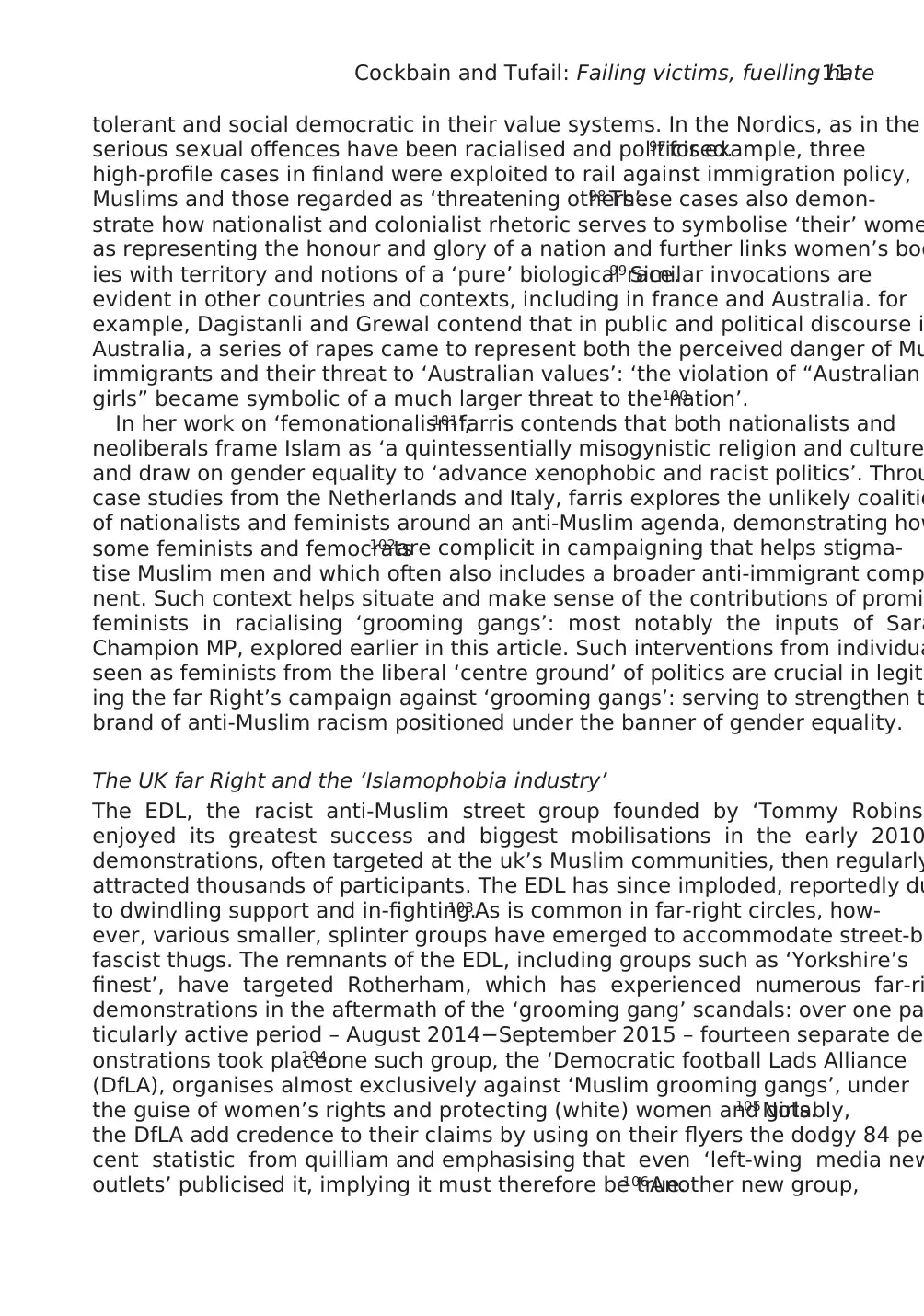
Cockbain and Tufail: Failing victims, fuelling hate11
tolerant and social democratic in their value systems. In the Nordics, as in the
serious sexual offences have been racialised and politicised.97 for example, three
high-profile cases in finland were exploited to rail against immigration policy,
Muslims and those regarded as ‘threatening others’.98 These cases also demon-
strate how nationalist and colonialist rhetoric serves to symbolise ‘their’ wome
as representing the honour and glory of a nation and further links women’s bod
ies with territory and notions of a ‘pure’ biological race.99 Similar invocations are
evident in other countries and contexts, including in france and Australia. for
example, Dagistanli and Grewal contend that in public and political discourse i
Australia, a series of rapes came to represent both the perceived danger of Mu
immigrants and their threat to ‘Australian values’: ‘the violation of “Australian
girls” became symbolic of a much larger threat to the nation’.100
In her work on ‘femonationalism’,101 farris contends that both nationalists and
neoliberals frame Islam as ‘a quintessentially misogynistic religion and culture
and draw on gender equality to ‘advance xenophobic and racist politics’. Throu
case studies from the Netherlands and Italy, farris explores the unlikely coalitio
of nationalists and feminists around an anti-Muslim agenda, demonstrating how
some feminists and femocrats102 are complicit in campaigning that helps stigma-
tise Muslim men and which often also includes a broader anti-immigrant comp
nent. Such context helps situate and make sense of the contributions of promin
feminists in racialising ‘grooming gangs’: most notably the inputs of Sara
Champion MP, explored earlier in this article. Such interventions from individua
seen as feminists from the liberal ‘centre ground’ of politics are crucial in legiti
ing the far Right’s campaign against ‘grooming gangs’: serving to strengthen t
brand of anti-Muslim racism positioned under the banner of gender equality.
The UK far Right and the ‘Islamophobia industry’
The EDL, the racist anti-Muslim street group founded by ‘Tommy Robinso
enjoyed its greatest success and biggest mobilisations in the early 2010
demonstrations, often targeted at the uk’s Muslim communities, then regularly
attracted thousands of participants. The EDL has since imploded, reportedly du
to dwindling support and in-fighting.103 As is common in far-right circles, how-
ever, various smaller, splinter groups have emerged to accommodate street-ba
fascist thugs. The remnants of the EDL, including groups such as ‘Yorkshire’s
finest’, have targeted Rotherham, which has experienced numerous far-ri
demonstrations in the aftermath of the ‘grooming gang’ scandals: over one pa
ticularly active period – August 2014−September 2015 – fourteen separate dem
onstrations took place.104 one such group, the ‘Democratic football Lads Alliance
(DfLA), organises almost exclusively against ‘Muslim grooming gangs’, under
the guise of women’s rights and protecting (white) women and girls.105 Notably,
the DfLA add credence to their claims by using on their flyers the dodgy 84 per
cent statistic from quilliam and emphasising that even ‘left-wing media new
outlets’ publicised it, implying it must therefore be true.106 Another new group,
tolerant and social democratic in their value systems. In the Nordics, as in the
serious sexual offences have been racialised and politicised.97 for example, three
high-profile cases in finland were exploited to rail against immigration policy,
Muslims and those regarded as ‘threatening others’.98 These cases also demon-
strate how nationalist and colonialist rhetoric serves to symbolise ‘their’ wome
as representing the honour and glory of a nation and further links women’s bod
ies with territory and notions of a ‘pure’ biological race.99 Similar invocations are
evident in other countries and contexts, including in france and Australia. for
example, Dagistanli and Grewal contend that in public and political discourse i
Australia, a series of rapes came to represent both the perceived danger of Mu
immigrants and their threat to ‘Australian values’: ‘the violation of “Australian
girls” became symbolic of a much larger threat to the nation’.100
In her work on ‘femonationalism’,101 farris contends that both nationalists and
neoliberals frame Islam as ‘a quintessentially misogynistic religion and culture
and draw on gender equality to ‘advance xenophobic and racist politics’. Throu
case studies from the Netherlands and Italy, farris explores the unlikely coalitio
of nationalists and feminists around an anti-Muslim agenda, demonstrating how
some feminists and femocrats102 are complicit in campaigning that helps stigma-
tise Muslim men and which often also includes a broader anti-immigrant comp
nent. Such context helps situate and make sense of the contributions of promin
feminists in racialising ‘grooming gangs’: most notably the inputs of Sara
Champion MP, explored earlier in this article. Such interventions from individua
seen as feminists from the liberal ‘centre ground’ of politics are crucial in legiti
ing the far Right’s campaign against ‘grooming gangs’: serving to strengthen t
brand of anti-Muslim racism positioned under the banner of gender equality.
The UK far Right and the ‘Islamophobia industry’
The EDL, the racist anti-Muslim street group founded by ‘Tommy Robinso
enjoyed its greatest success and biggest mobilisations in the early 2010
demonstrations, often targeted at the uk’s Muslim communities, then regularly
attracted thousands of participants. The EDL has since imploded, reportedly du
to dwindling support and in-fighting.103 As is common in far-right circles, how-
ever, various smaller, splinter groups have emerged to accommodate street-ba
fascist thugs. The remnants of the EDL, including groups such as ‘Yorkshire’s
finest’, have targeted Rotherham, which has experienced numerous far-ri
demonstrations in the aftermath of the ‘grooming gang’ scandals: over one pa
ticularly active period – August 2014−September 2015 – fourteen separate dem
onstrations took place.104 one such group, the ‘Democratic football Lads Alliance
(DfLA), organises almost exclusively against ‘Muslim grooming gangs’, under
the guise of women’s rights and protecting (white) women and girls.105 Notably,
the DfLA add credence to their claims by using on their flyers the dodgy 84 per
cent statistic from quilliam and emphasising that even ‘left-wing media new
outlets’ publicised it, implying it must therefore be true.106 Another new group,
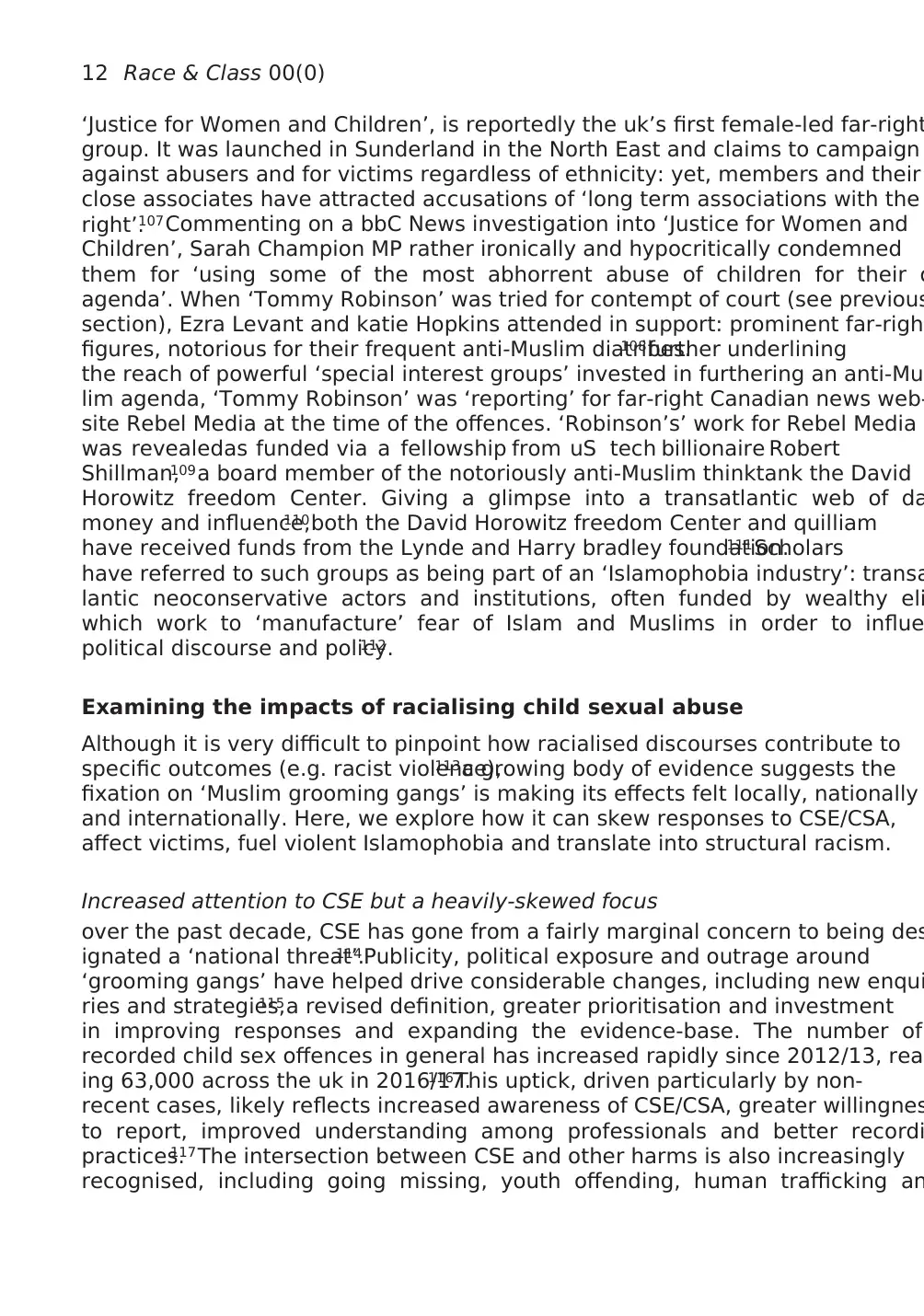
12 Race & Class 00(0)
‘Justice for Women and Children’, is reportedly the uk’s first female-led far-right
group. It was launched in Sunderland in the North East and claims to campaign
against abusers and for victims regardless of ethnicity: yet, members and their
close associates have attracted accusations of ‘long term associations with the
right’.107 Commenting on a bbC News investigation into ‘Justice for Women and
Children’, Sarah Champion MP rather ironically and hypocritically condemned
them for ‘using some of the most abhorrent abuse of children for their o
agenda’. When ‘Tommy Robinson’ was tried for contempt of court (see previous
section), Ezra Levant and katie Hopkins attended in support: prominent far-right
figures, notorious for their frequent anti-Muslim diatribes.108 further underlining
the reach of powerful ‘special interest groups’ invested in furthering an anti-Mus
lim agenda, ‘Tommy Robinson’ was ‘reporting’ for far-right Canadian news web-
site Rebel Media at the time of the offences. ‘Robinson’s’ work for Rebel Media
was revealedas funded via a fellowship from uS tech billionaire Robert
Shillman,109 a board member of the notoriously anti-Muslim thinktank the David
Horowitz freedom Center. Giving a glimpse into a transatlantic web of da
money and influence,110 both the David Horowitz freedom Center and quilliam
have received funds from the Lynde and Harry bradley foundation.111 Scholars
have referred to such groups as being part of an ‘Islamophobia industry’: transa
lantic neoconservative actors and institutions, often funded by wealthy eli
which work to ‘manufacture’ fear of Islam and Muslims in order to influe
political discourse and policy.112
Examining the impacts of racialising child sexual abuse
Although it is very difficult to pinpoint how racialised discourses contribute to
specific outcomes (e.g. racist violence),113 a growing body of evidence suggests the
fixation on ‘Muslim grooming gangs’ is making its effects felt locally, nationally
and internationally. Here, we explore how it can skew responses to CSE/CSA,
affect victims, fuel violent Islamophobia and translate into structural racism.
Increased attention to CSE but a heavily-skewed focus
over the past decade, CSE has gone from a fairly marginal concern to being des
ignated a ‘national threat’.114 Publicity, political exposure and outrage around
‘grooming gangs’ have helped drive considerable changes, including new enqui
ries and strategies,115 a revised definition, greater prioritisation and investment
in improving responses and expanding the evidence-base. The number of
recorded child sex offences in general has increased rapidly since 2012/13, reac
ing 63,000 across the uk in 2016/17.116 This uptick, driven particularly by non-
recent cases, likely reflects increased awareness of CSE/CSA, greater willingnes
to report, improved understanding among professionals and better recordi
practices.117 The intersection between CSE and other harms is also increasingly
recognised, including going missing, youth offending, human trafficking an
‘Justice for Women and Children’, is reportedly the uk’s first female-led far-right
group. It was launched in Sunderland in the North East and claims to campaign
against abusers and for victims regardless of ethnicity: yet, members and their
close associates have attracted accusations of ‘long term associations with the
right’.107 Commenting on a bbC News investigation into ‘Justice for Women and
Children’, Sarah Champion MP rather ironically and hypocritically condemned
them for ‘using some of the most abhorrent abuse of children for their o
agenda’. When ‘Tommy Robinson’ was tried for contempt of court (see previous
section), Ezra Levant and katie Hopkins attended in support: prominent far-right
figures, notorious for their frequent anti-Muslim diatribes.108 further underlining
the reach of powerful ‘special interest groups’ invested in furthering an anti-Mus
lim agenda, ‘Tommy Robinson’ was ‘reporting’ for far-right Canadian news web-
site Rebel Media at the time of the offences. ‘Robinson’s’ work for Rebel Media
was revealedas funded via a fellowship from uS tech billionaire Robert
Shillman,109 a board member of the notoriously anti-Muslim thinktank the David
Horowitz freedom Center. Giving a glimpse into a transatlantic web of da
money and influence,110 both the David Horowitz freedom Center and quilliam
have received funds from the Lynde and Harry bradley foundation.111 Scholars
have referred to such groups as being part of an ‘Islamophobia industry’: transa
lantic neoconservative actors and institutions, often funded by wealthy eli
which work to ‘manufacture’ fear of Islam and Muslims in order to influe
political discourse and policy.112
Examining the impacts of racialising child sexual abuse
Although it is very difficult to pinpoint how racialised discourses contribute to
specific outcomes (e.g. racist violence),113 a growing body of evidence suggests the
fixation on ‘Muslim grooming gangs’ is making its effects felt locally, nationally
and internationally. Here, we explore how it can skew responses to CSE/CSA,
affect victims, fuel violent Islamophobia and translate into structural racism.
Increased attention to CSE but a heavily-skewed focus
over the past decade, CSE has gone from a fairly marginal concern to being des
ignated a ‘national threat’.114 Publicity, political exposure and outrage around
‘grooming gangs’ have helped drive considerable changes, including new enqui
ries and strategies,115 a revised definition, greater prioritisation and investment
in improving responses and expanding the evidence-base. The number of
recorded child sex offences in general has increased rapidly since 2012/13, reac
ing 63,000 across the uk in 2016/17.116 This uptick, driven particularly by non-
recent cases, likely reflects increased awareness of CSE/CSA, greater willingnes
to report, improved understanding among professionals and better recordi
practices.117 The intersection between CSE and other harms is also increasingly
recognised, including going missing, youth offending, human trafficking an
⊘ This is a preview!⊘
Do you want full access?
Subscribe today to unlock all pages.

Trusted by 1+ million students worldwide
1 out of 30
Your All-in-One AI-Powered Toolkit for Academic Success.
+13062052269
info@desklib.com
Available 24*7 on WhatsApp / Email
![[object Object]](/_next/static/media/star-bottom.7253800d.svg)
Unlock your academic potential
Copyright © 2020–2025 A2Z Services. All Rights Reserved. Developed and managed by ZUCOL.